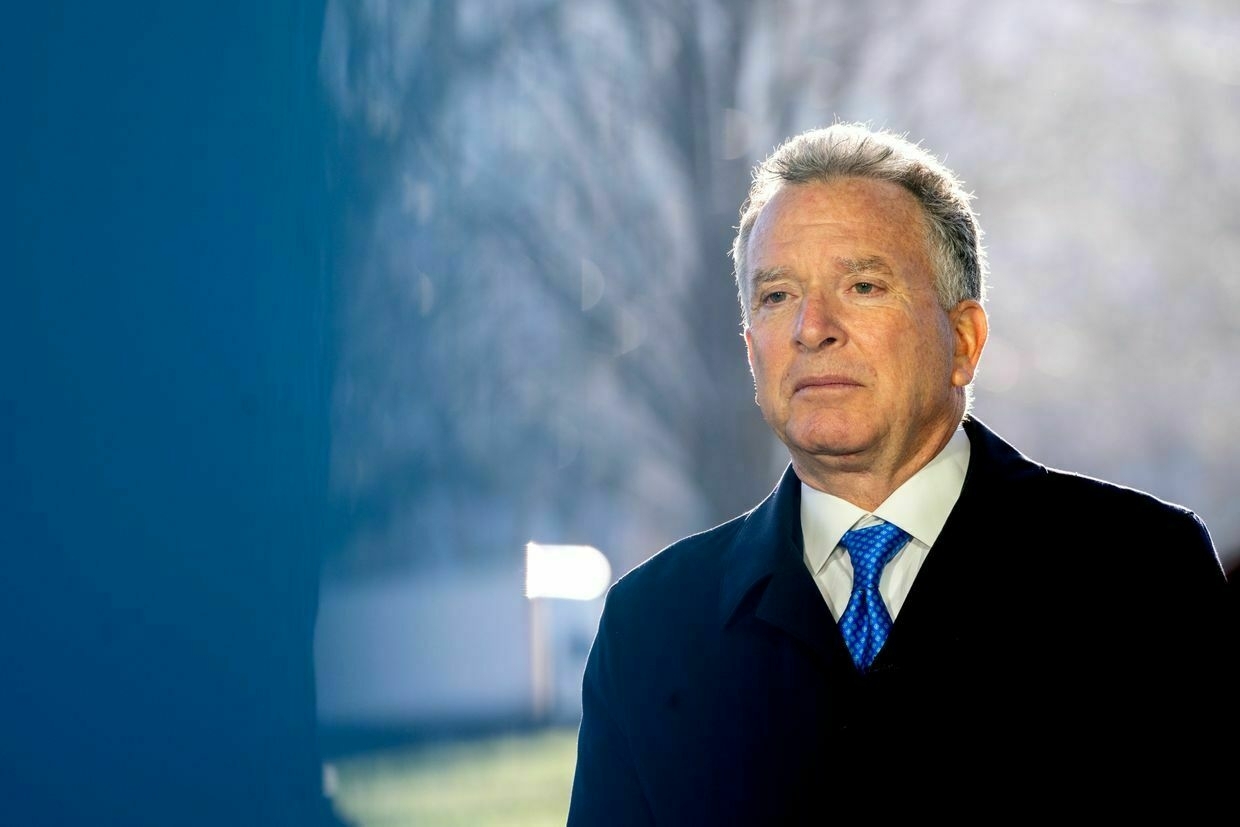-
EU fails to agree on sanctions on Russian LNG, Reuters reports
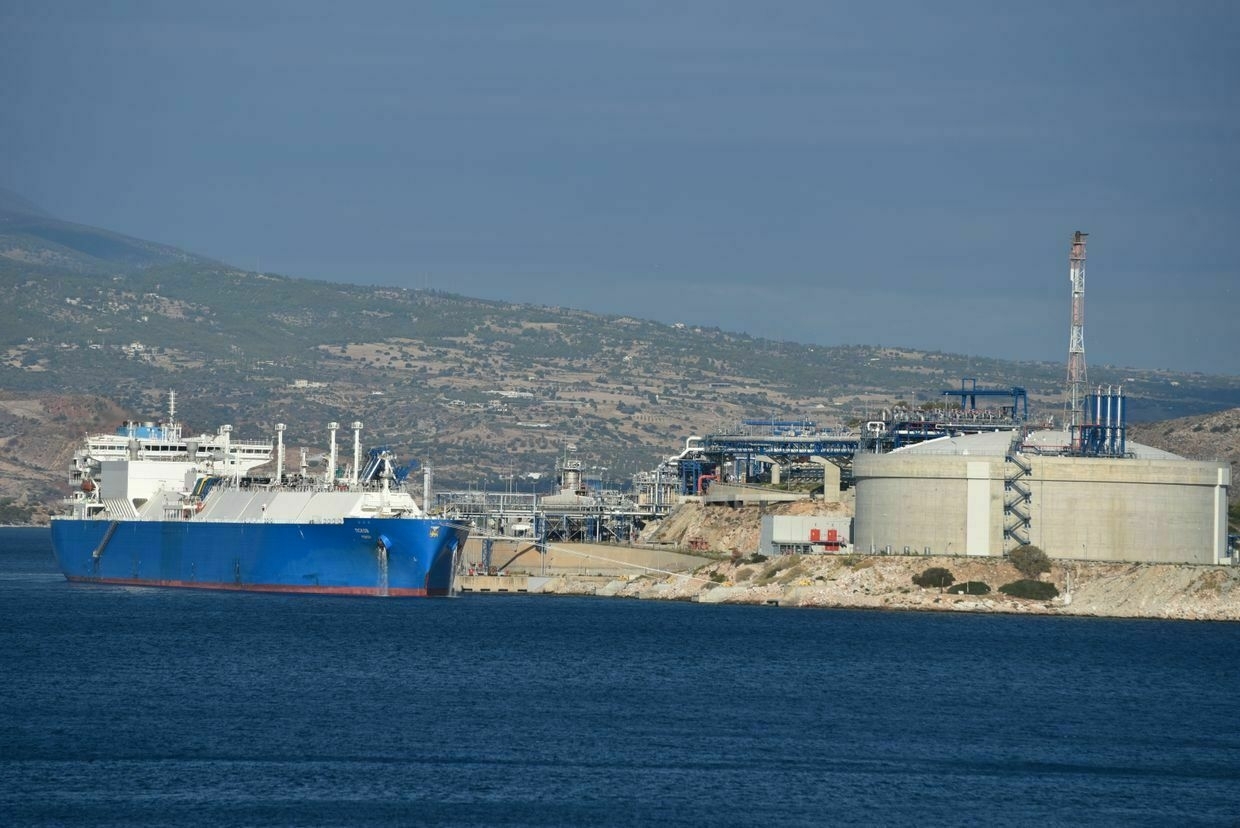
The EU has shelved the idea of banning Russian liquified natural gas (LNG) imports due to opposition from some members and uncertainty about alternative supplies, Reuters reported on April 16, citing undisclosed EU officials.
This means that restrictions on Russian LNG are unlikely to be part of the EU’s upcoming 17th sanctions package.
Following Russia’s full-scale invasion of Ukraine in 2022, Europe began to wean itself off Russian fossil fuels to avoid financing the Kremlin’s war chest.
Despite these efforts, Europe’s imports of Russian LNG, which is largely not subject to sanctions, have soared to record levels in 2024. A ban on Russian LNG has been debated for months, but the members have struggled to find consensus on the issue.
U.S. President Donald Trump has pushed for the EU to start purchasing U.S. LNG instead, but details of such a potential deal remain unclear.
As economic relations between the U.S. and the EU sour over Trump’s new sweeping tariffs, Brussels wants to use Russian LNG supplies as leverage in trade talks with Washington, a European Commission official told Reuters.
The EU is also careful not to create a dependency on the U.S. either, according to the news agency. Trump’s sweeping import duties on much of the world, as well as a foreign policy pivot away from European partners and embrace of Moscow, raise concerns in Europe that Washington is no longer a reliable partner.
The European bloc plans to completely phase out Russian fossil fuels by 2027, and the European Commission is expected to provide a plan by May 6 – a deadline postponed from March amid uncertainty over Trump’s tariffs.
Trump’s Ukraine peace push is really about business — and Putin knows itThe American and Russian delegations that just met in Istanbul had made it clear that they were there to discuss the normalization of their diplomatic missions’ work, not the war in Ukraine. But such engagement is a clear corollary to U.S. President Donald Trump’s efforts to negotiate anThe Kyiv IndependentNina L. Khrushcheva
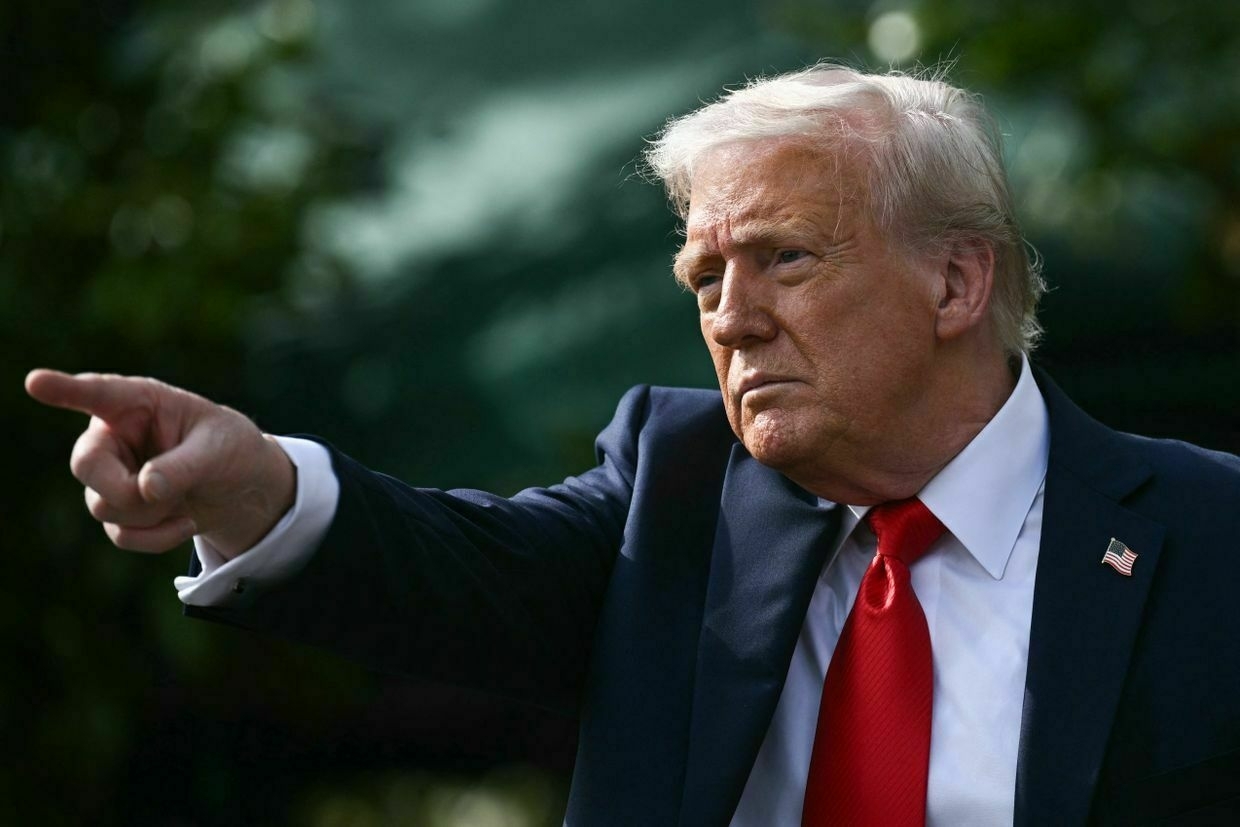
-
Nearly 102,000 Russian soldiers killed in Ukraine identified by media investigation
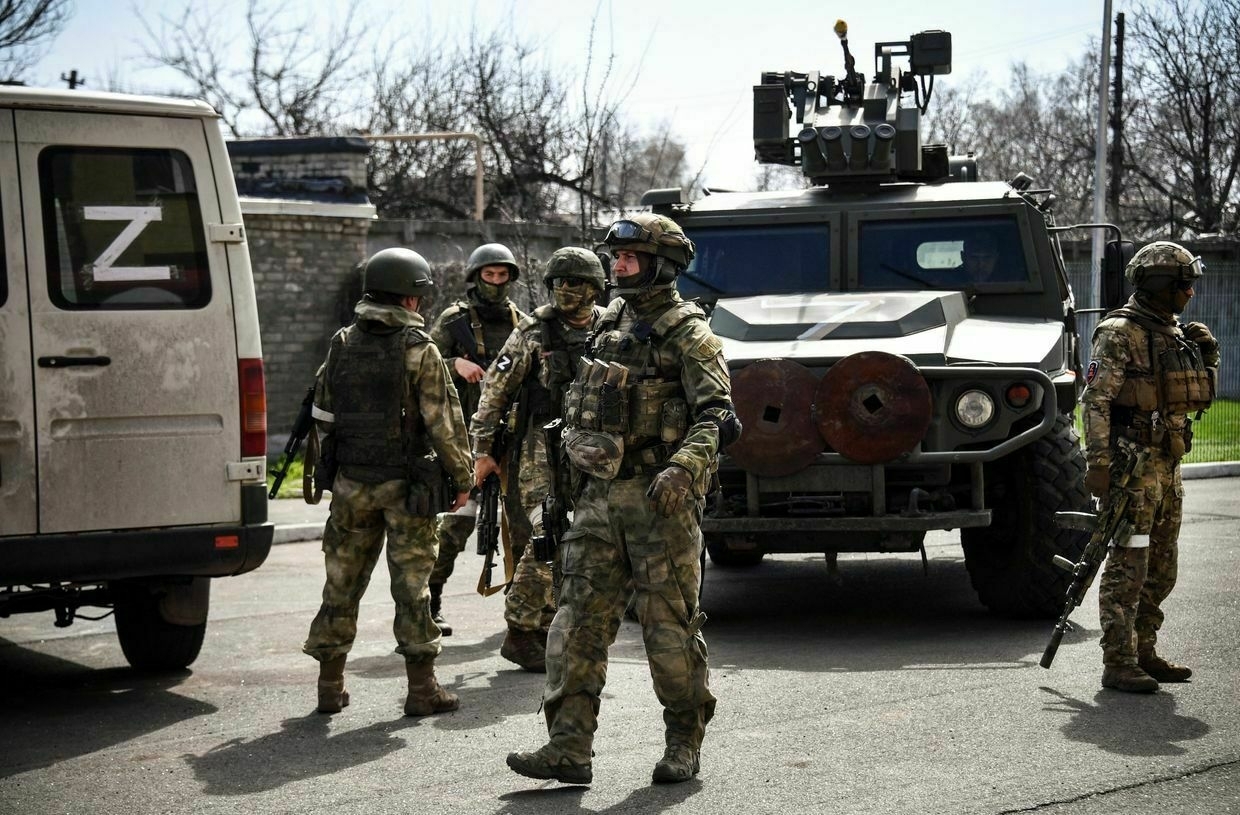
Russian independent media outlet, Mediazona, in collaboration with the BBC Russian service, has confirmed the identities of 101,833 Russian military personnel killed in Ukraine.
Mediazona’s latest report covers the period of February 24, 2022 to April 7, 2025. Since it was last updated at the end of March, 1,882 additional Russian military personnel have been killed.
The list of deceased Russian military personnel is compiled from verified, publicly available sources, including social media posts, local news reports, and official announcements from regional authorities.
However, as the Russian government does not publicly disclose casualty information, journalists note that the total number of casualties is likely higher than reported.
Mediazona estimates that at least 165,000 military personnel have been killed in the invasion.
Of the total confirmed casualties, at least 4,897 officers have been killed. More than 24,800 volunteers have been killed as well, accounting for 24.3% of the total Russian losses.
The media outlet publicly released the full list of named casualties for the first time in February, commemorating the third-year anniversary of Russia’s full-scale invasion of Ukraine.
As of April 16, Russia has lost a total of 936,210 troops since the full-scale invasion began, Ukraine’s General Staff reported. The estimate, which is broadly in-line with estimates made by Western intelligence agencies, likely includes those killed, captured, wounded, and missing.
From hospitals to malls, the deadliest Russian strikes on civilians in Ukraine so farAfter Russia launched a missile strike at the city of Sumy on Palm Sunday — killing 35 civilians, including children, and injuring over 100 others — U.S. President Donald Trump wrote off the attack as a “mistake.” “I think it was terrible, and I was told they made a mistake, butThe Kyiv IndependentNatalia Yermak
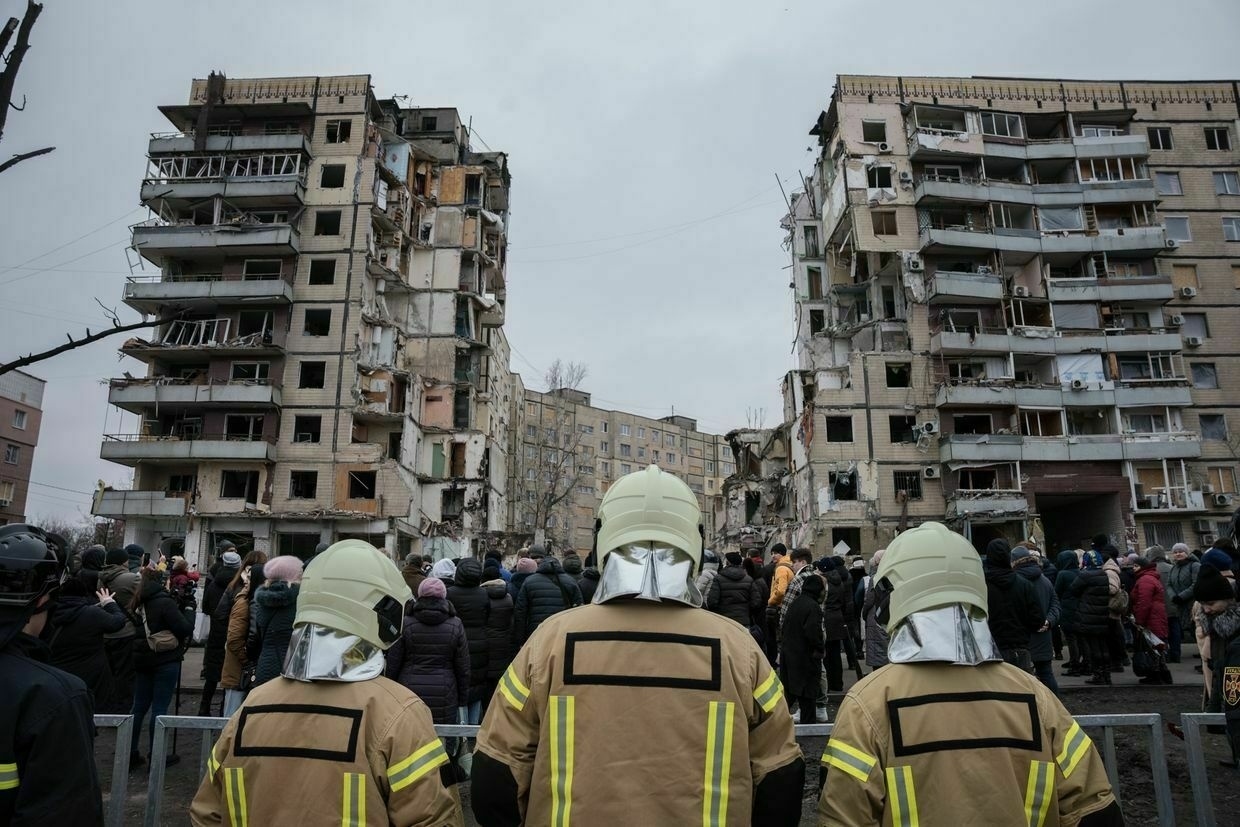
-
Trump extends US sanctions on Russian ships for another year

U.S. President Donald Trump has extended sanctions on Russian and Russian-affiliated vessels, according to a U.S. Federal Register document released on April 15 and scheduled for publication on April 17.
Trump has “been continually frustrated” with both Ukraine and Russia as U.S.-led ceasefire negotiations drag on, White House Press Secretary Karoline Leavitt told reporters on April 11. Trump earlier signed an executive order extending sanctions against Russia for one year, originally imposed by former U.S. President Joe Biden in April 2021.
“I am continuing for one year the national emergency with respect to the Russian Federation and the emergency authority relating to the regulation of the anchorage and movement of Russian-affiliated vessels to United States ports,” the document says.
On April 9, a bipartisan group of U.S. senators introduced legislation to heighten the enforcement of sanctions against Russia’s so-called “shadow fleet” of oil tankers, seeking to crack down on oil revenues that fund Russia’s war against Ukraine.
"Russia is continuing its malign actions by operating a ‘ghost fleet’ to evade U.S. sanctions, enrich its own war machine, and even aid Iranian oil smuggling," one of the sponsors of the bill, Republican Senator Joni Ernst, said.
On April 10, President Volodymyr Zelensky announced a new sanctions package targeting Russia’s “shadow fleet."
The “shadow fleet” aims to circumvent sanctions imposed against Russia and continue flows of oil revenue to Moscow.
"(The sanctions) target, in particular, the shadow tanker fleet that Moscow uses to finance the war; war propagandists — those who are trying to undermine our defense and help Russia; and also certain officials — these are names well known to all Ukrainians — who used to have influence," Zelensky said.
Trump’s Ukraine peace push is really about business — and Putin knows itThe American and Russian delegations that just met in Istanbul had made it clear that they were there to discuss the normalization of their diplomatic missions’ work, not the war in Ukraine. But such engagement is a clear corollary to U.S. President Donald Trump’s efforts to negotiate anThe Kyiv IndependentNina L. Khrushcheva
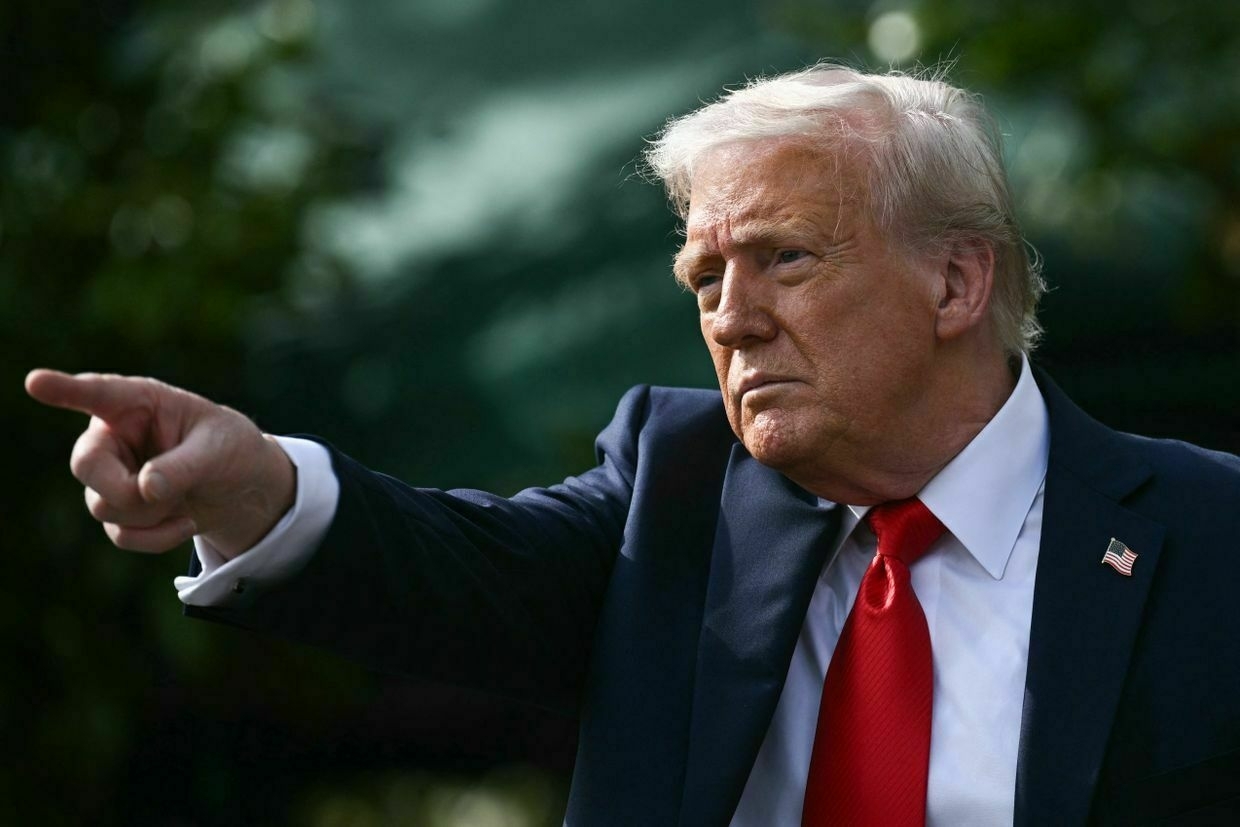
-
Russia’s War Funding Crisis, Trump’s Tariff Shifts and Europe’s Strategic Response | News Pulse
-
Ukraine war latest: Ukrainian drones reportedly strike another Russian missile brigade linked to Sumy attack
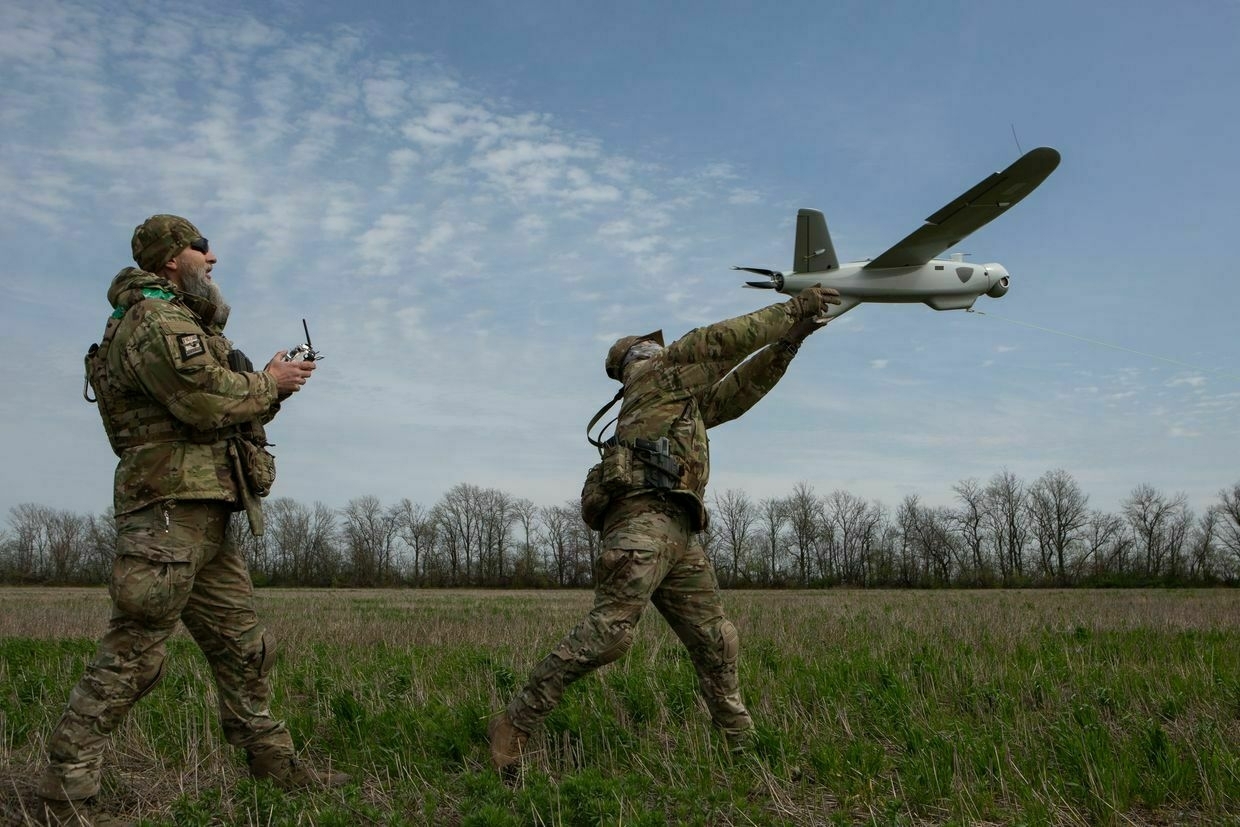
Key developments on April 16:
- Ukrainian drones reportedly strike another Russian missile brigade linked to Sumy attack
- North Korea earns over $20 billion aiding Russia’s war effort, report says
- Kyiv doesn’t rule out North Korean participation in Russia’s assault on Sumy, Kharkiv oblasts
- Russia arms ‘kamikaze’ drones with chemical weapons, Ukraine says
- Russia has violated ‘energy ceasefire’ more than 30 times, Ukraine says
Ukrainian drones struck the Russian city of Shuya in Ivanovo Oblast on April 16, reportedly targeting military infrastructure linked to Russia’s 112th Missile Brigade, according to independent Russian media outlet Astra.
The 112th Brigade, along with the 448th Missile Brigade, was involved in a deadly missile strike on the Ukrainian city of Sumy on Palm Sunday on April 13 that killed at least 35 civilians, Ukraine’s intelligence said.
The Russian Defense Ministry claimed that seven Ukrainian drones were destroyed over Ivanovo Oblast on April 16. Local authorities reported no fatalities, but two people were reportedly injured and received medical attention.
The Kyiv Independent could not verify the claims.
Photos from the scene show plumes of smoke, and military equipment was deployed in the city, according to Astra.
Shuya is situated on the Teza River, approximately 33 kilometers (20 miles) from the regional center, Ivanovo. It lies about 700 kilometers (435 miles) northeast of the Ukrainian border.
Earlier, Ukraine’s General Staff confirmed on April 15 that its forces had also targeted and struck the base of the 448th Missile Brigade in Kursk Oblast.
The operation involved Ukraine’s Unmanned Systems Forces, the Special Operations Forces, and the Security Service of Ukraine (SBU) and was launched as retaliation for the Sumy attack.
Ukrainian officials have asserted that cluster munitions were used in the Sumy attack, a serious violation of international humanitarian law when used in civilian areas. The international community widely condemned the strike, labeling it a war crime.
Ukraine’s military has pledged to track and retaliate against all Russian units involved in targeting civilian populations.
North Korea earns over $20 billion aiding Russia's war effort, report saysNorth Korea's military support for Russia's full-scale war against Ukraine has already earned Pyongyang more than $20 billion, according to South Korea's Institute for Defense Analyses (KIDA), Newsweek reported on April 16.
KIDA's estimates show that most revenue stems from large-scale artillery ammunition shipments. North Korean munitions now account for roughly half of the Russian army's artillery needs in Ukraine, with some front-line units entirely reliant on the shells.
Between August 2023 and March 2025, North Korea reportedly shipped more than 15,800 containers of munitions to Russia. Satellite imagery revealed 64 voyages by Russian ships, potentially delivering between 4.2 million and 5.8 million rounds of North Korean ammunition.
In return, Pyongyang is said to have received advanced Russian weaponry and military technology, rather than cash. The report suggests North Korea prefers "in-kind and technical assistance" that enhances its own defense industry and supports its long-term strategic goals.
North Korea deployed more than 11,000 troops to support Russia's war efforts, most of whom were sent to Russia's Kursk Oblast. Ukraine estimates 5,000-6,000 casualties among them, highlighting the high human cost of Pyongyang's involvement.
The deepening military alliance raises broader regional concerns, with KIDA warning that closer cooperation could lead to Moscow intervening on the Korean Peninsula in the event of a crisis.
"Russia-North Korea military cooperation raises the chances of Russia stepping in on the Korean peninsula if there's an emergency," the report said, urging the international community to adopt measures to sever the alliance.
Russian President Vladimir Putin has described North Korea as a "partner," confirming that a bilateral defense treaty signed in 2024 is now in force. He has also suggested that Pyongyang could be included in future negotiations to end the war in Ukraine.
Can civilian areas ever be legitimate military targets? We asked an expertApril 13 marked Russia’s deadliest attack on the northeastern city of Sumy, killing 35 people and injuring nearly 120. As locals flocked to the city center on the morning of Palm Sunday, Russia launched two ballistic missiles in what is known as a double-tap attack. The second missile, firedThe Kyiv IndependentDaria Shulzhenko
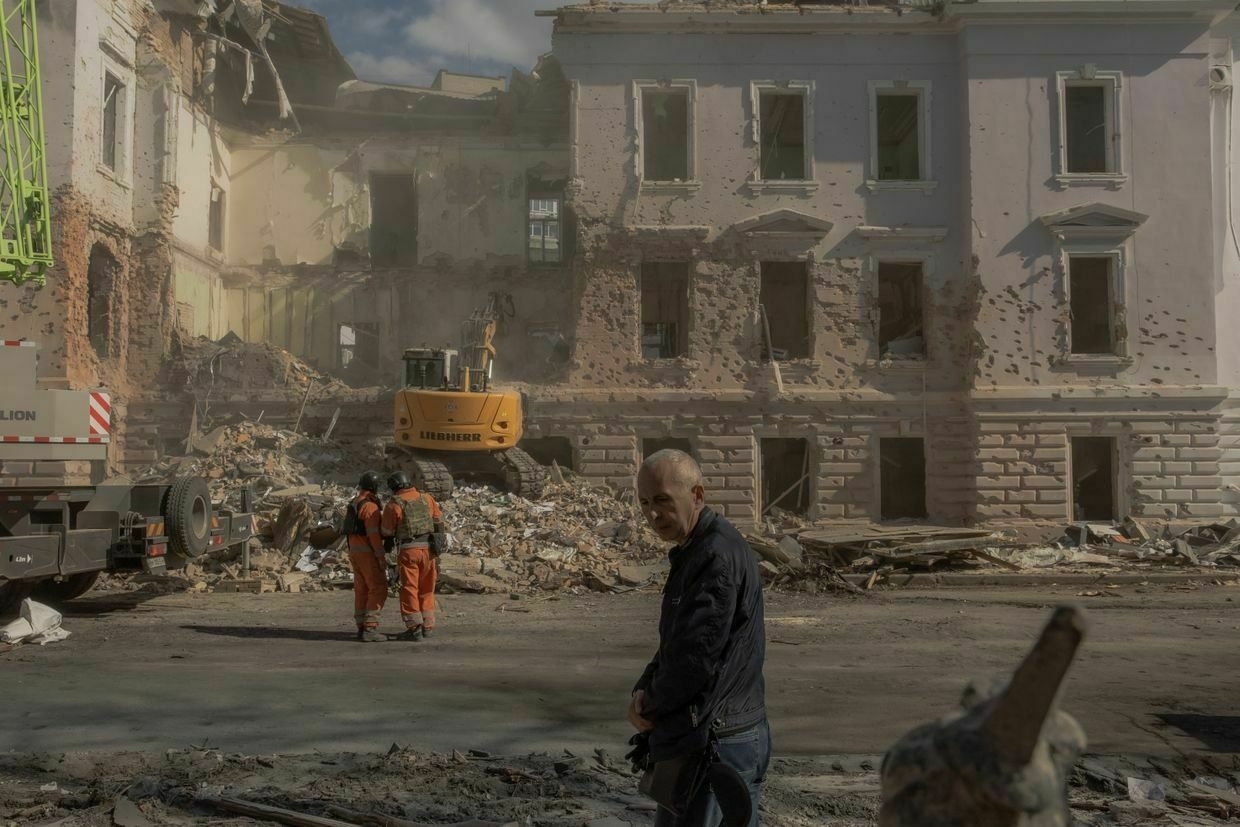
Kyiv doesn't rule out North Korean participation in Russia's assault on Sumy, Kharkiv oblastsUkraine does not rule out the possibility that Russia will deploy North Korean troops in the offensives against the northeastern Sumy and Kharkiv oblasts, Andrii Cherniak, spokesperson for Ukraine's military intelligence (HUR), told Japanese broadcaster NHK in comments published on April 15.
The warning follows a statement from Commander-in-Chief Oleksandr Syrskyi, who said on April 9 that Moscow's spring offensive "has actually already begun."
"Unfortunately, we can talk about the evolution, about the successful training of the North Korean military," Cherniak told NHK last week, noting that Pyongyang's forces have adopted Russian tactics of using drones and electronic warfare systems.
According to the intelligence spokesperson, North Korean troops operate in small assault groups and do not require ongoing coordination with Russian commanders.
They are instructed to "reach this or that frontier," after which they move forward independently, Cherniak explained. He added that the soldiers do not constantly communicate with the Russian side.
Cherniak warned that their battlefield experience will be transferred back to North Korea and shared with other units, reinforcing Pyongyang's capabilities and contributing to instability in the Asia-Pacific region.
Cherniak's comments come amid reports of other foreign fighters aiding Moscow. President Volodymyr Zelensky said on April 11 that "several hundred" Chinese nationals are also fighting in Russian ranks. Two were captured in Donetsk Oblast earlier this month.
Beijing has denied any direct involvement in the war, saying it has always appealed to its citizens to avoid armed conflicts.
Russia arms 'kamikaze' drones with chemical weapons, Ukraine saysRussian forces have deployed Shahed-type "kamikaze" drones carrying toxic substances to attack Ukraine, the Center for Countering Disinformation at Ukraine's National Security and Defense Council said on April 16.
Russia has been intensifying its use of chemical agents on the battlefield in Ukraine, with Kyiv recording over 6,000 cases of use of munitions containing hazardous chemicals between February 2023 and 2025.
A capsule with CS gas, a riot control agent, was found in one Russian drone, the center said, adding it had verified the information with Ukraine's security services and the State Emergency Service.
CS gas, also referred to as tear gas, is typically used as a crowd-control agent by law enforcement agencies around the world and is less lethal than other chemical weapons. Its battlefield use is nevertheless banned under the 1925 Geneva Protocol.
"Russian forces may scatter the capsules with poisonous substances to cause harm," the center said on Telegram. At the same time, the agency noted that claims circulating in the media that the drones themselves are coated with poisonous substances have not been confirmed.
Since the beginning of the all-out war, Ukraine's radiation, chemical, and biological intelligence units have been monitoring and recording the use of hazardous chemicals in attacks.
Ukraine struck back at Russia's use of illegal chemical weapons in December 2024, when the Security Service of Ukraine (SBU) assassinated Lieutenant General Igor Kirillov, the head of the Russian Armed Forces' radiation, chemical, and biological defense troops.
As Trump and Moscow align their vision, battle to stabilize Donetsk front rests on a knife edgeEditor’s note: In accordance with the security protocols of the Ukrainian military, soldiers featured in this story are identified by first names and callsigns only. DONETSK OBLAST – Scanning an array of nine video feeds from a command point in an abandoned summer, mortar battery commander Tymur “B…The Kyiv IndependentFrancis Farrell
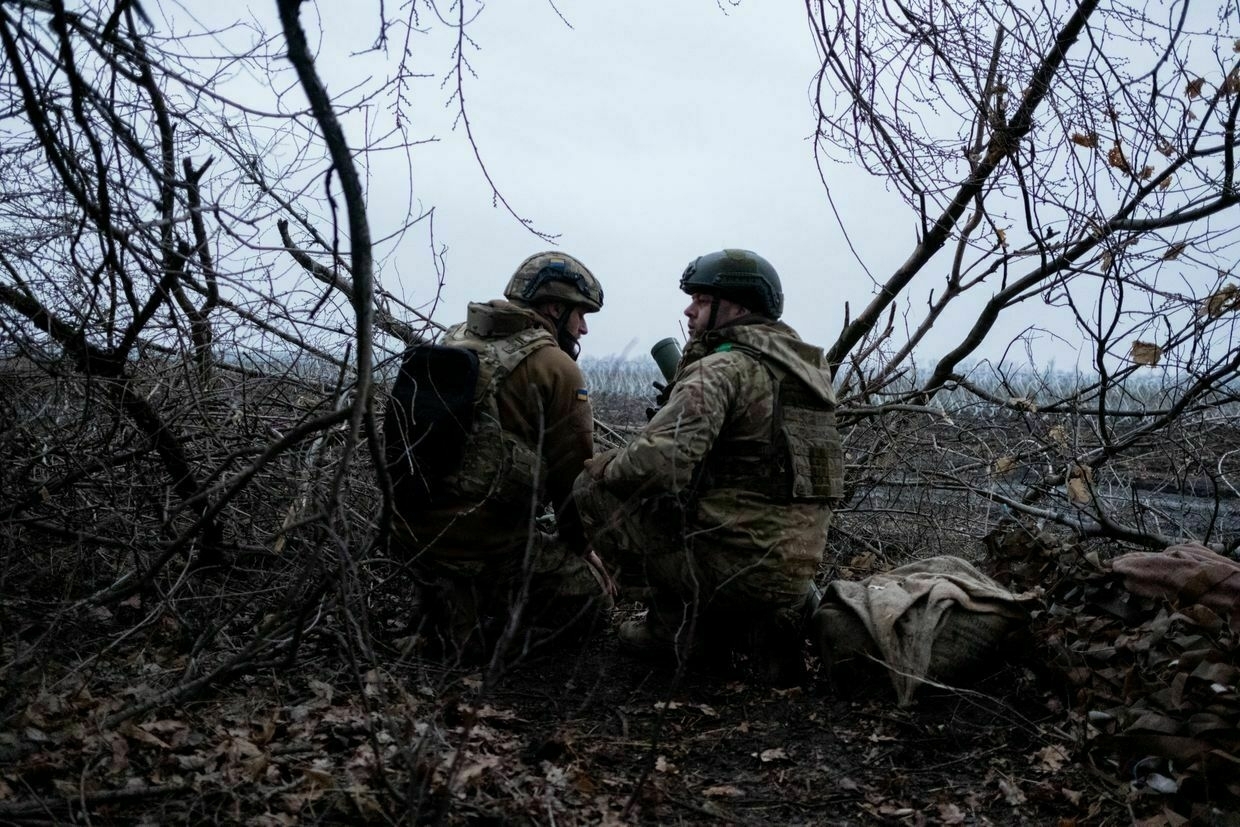
Russia has violated 'energy ceasefire' more than 30 times, Ukraine saysRussia has violated a partial ceasefire covering energy infrastructure more than 30 times since it was agreed in March, targeting critical infrastructure across Ukraine, a Ukrainian Foreign Ministry spokesperson said on April 16.
"We regularly send detailed information on each of these violations to partner countries and the headquarters of international organizations," Foreign Ministry spokesperson Heorhii Tykhyi said during a briefing, Ukrinform reported.
Tykhyi noted that three violations were recorded in the past 24 hours. Russian attacks damaged transformers in Mykolaiv Oblast and near Kherson and a power transmission line in Poltava Oblast.
He emphasized that Ukrainian officials are actively sharing information about the breaches with international partners, including the U.S.
The energy ceasefire was intended to shield power infrastructure from attacks and has been in place since March 25. Kyiv has repeatedly accused Moscow of repeatedly disregarding the arrangement.
Russian President Vladimir Putin agreed to a 30-day pause of energy infrastructure strikes during a call with U.S. President Donald Trump on March 18, allegedly ordering a halt of attacks on Ukraine's energy system.
The partial ceasefire agreed to in March also included a maritime truce in the Black Sea. As part of the arrangement, Washington pledged to help facilitate Russia's agricultural and fertilizer exports by easing maritime insurance costs and improving access to ports and payment systems.
The Kremlin stated that its participation in the partial ceasefire in the Black Sea would only begin once certain Western sanctions were lifted.
Ukraine and the United States previously agreed to a complete 30-day ceasefire during talks in Jeddah on March 11. Russia rejected the proposal unless it included concessions that would undermine Kyiv's ability to defend itself, including a full halt to foreign military aid.
While U.S.-led diplomatic efforts to end the war are ongoing, Ukrainian officials say Russia continues to insist on maximalist demands and has shown little willingness to pursue a comprehensive peace agreement. Kyiv maintains it is ready for a complete ceasefire if Moscow agrees to reciprocate.
Throughout the full-scale war, Russia has consistently targeted Ukraine's power grid with missile and drone strikes. In response, Ukraine has used long-range drones to strike oil and gas facilities deep inside Russian territory.
Note from the author:
Ukraine War Latest is put together by the Kyiv Independent news desk team, who keep you informed 24 hours a day, seven days a week. If you value our work and want to ensure we have the resources to continue, join the Kyiv Independent community.
Can civilian areas ever be legitimate military targets? We asked an expertApril 13 marked Russia’s deadliest attack on the northeastern city of Sumy, killing 35 people and injuring nearly 120. As locals flocked to the city center on the morning of Palm Sunday, Russia launched two ballistic missiles in what is known as a double-tap attack. The second missile, firedThe Kyiv IndependentDaria Shulzhenko

-
Trump Is Down On 200B - What Will Ukraine Say?
-
EU confirms discussions on possible deployment of 'military advisors' to Ukraine
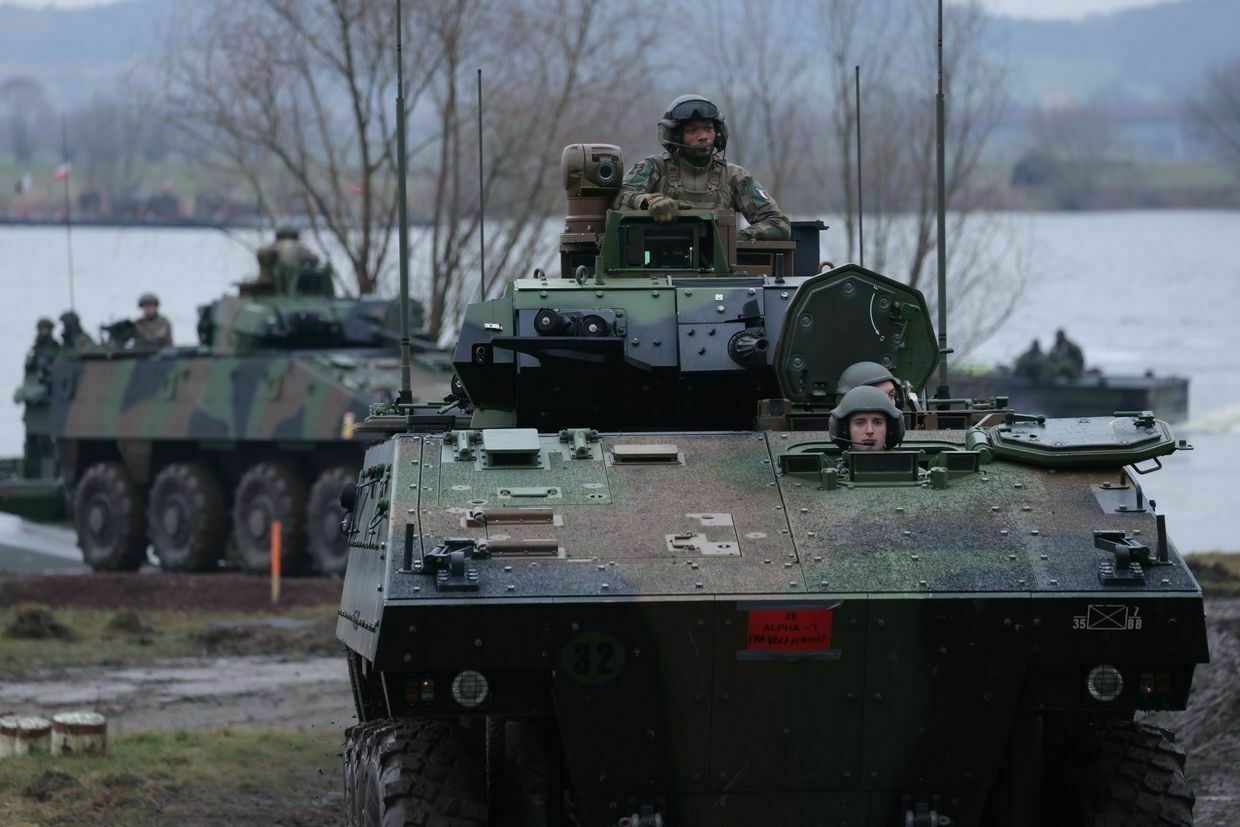
The European Union is considering sending “military advisors” to Ukraine to organize training for the Ukrainian military, European Commission spokesperson Anitta Hipper said on April 16 at a press briefing in Brussels.
Hipper’s statement comes after Hungarian Foreign Minister Peter Szijjarto said EU member states discussed the initiative during the EU Foreign Ministers Council meeting in Luxembourg on April 14.
“Indeed, this was discussed,” Hipper said. “But the main point is here to support Ukraine and strengthen Ukraine as much as possible."
“The discussions are ongoing as regards the adaptation to the mission, but there is nothing further I can share at this moment,” she added.
Hipper refused to specify if the plan included sending military advisors during the war or after it ended.
Following the April 14 meeting, EU foreign policy chief Kaja Kallas also mentioned discussions on a possible training mission.
“We have the mission of training Ukrainian soldiers, over 73,000 soldiers have already been trained. So today (April 14), we also discussed what more we can do when it comes to the missions,” Kallas said.
“Should we expand the mandate of the missions to contribute to the security guarantees of the coalition of the willing?” she added.
Kallas did not provide any further details.
The coalition is a group of countries that have pledged peacekeeping troops and other security guarantees for Ukraine in a potential ceasefire.
At least 37 countries, including European, Asian, and Commonwealth nations, have been involved in the coalition’s discussions, with 15 reportedly ready to contribute their troops. Other members have been asked to provide other forms of support, including intelligence, arms, or naval support.
U.S. President Donald Trump has yet to offer any clear security guarantees to Ukraine and the coalition as Washington moves toward a reduced military presence on the continent.
Can civilian areas ever be legitimate military targets? We asked an expertApril 13 marked Russia’s deadliest attack on the northeastern city of Sumy, killing 35 people and injuring nearly 120. As locals flocked to the city center on the morning of Palm Sunday, Russia launched two ballistic missiles in what is known as a double-tap attack. The second missile, firedThe Kyiv IndependentDaria Shulzhenko
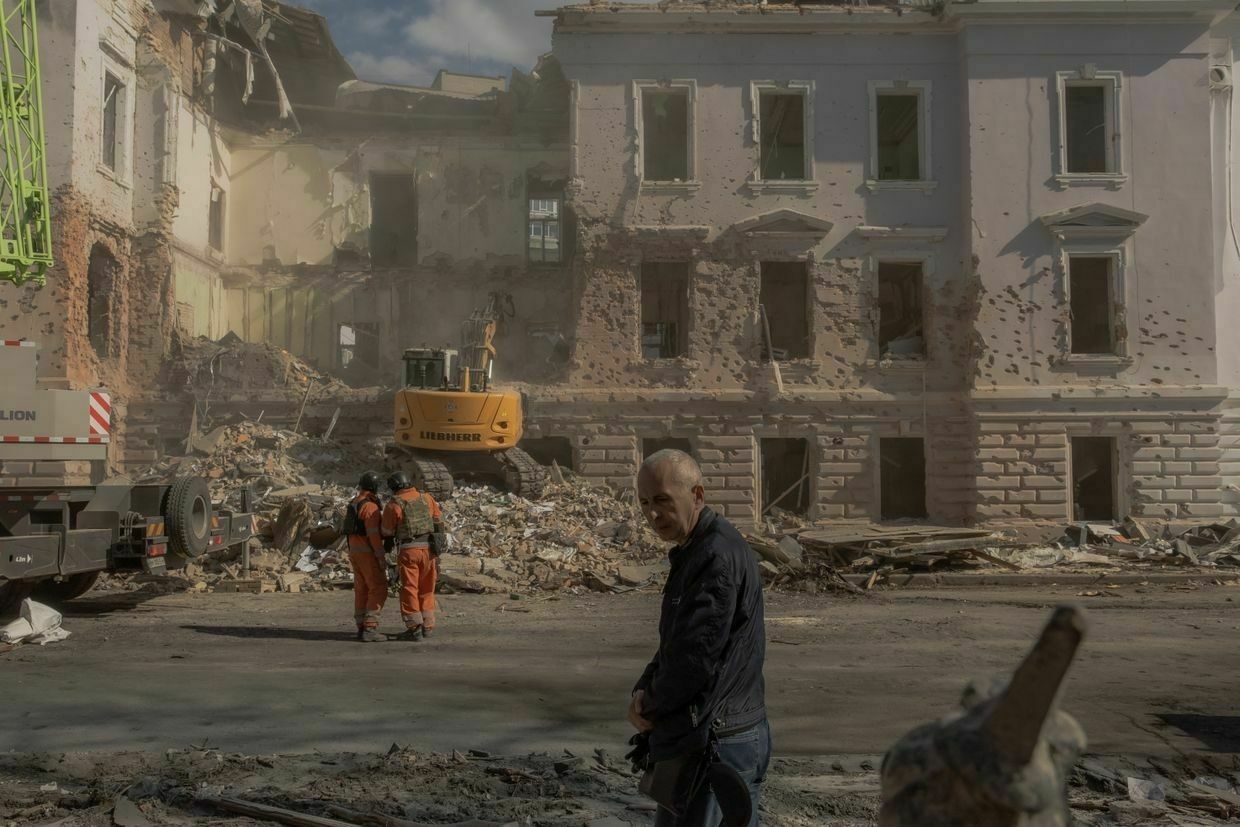
-
Russia has violated ‘energy ceasefire’ more than 30 times, Ukraine says
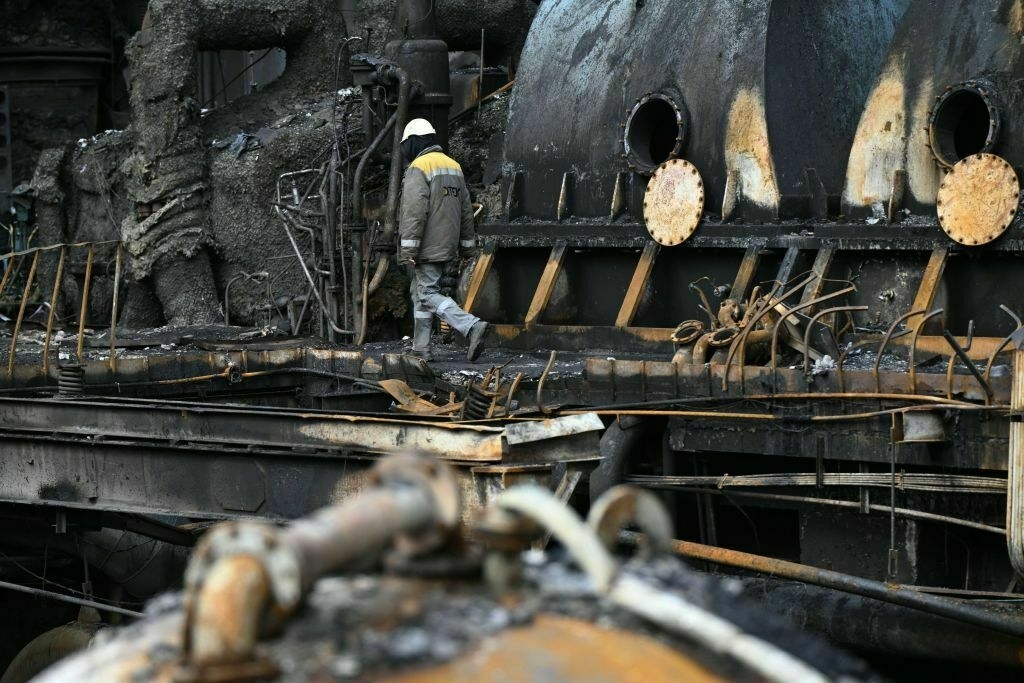
Russia has violated a partial ceasefire covering energy infrastructure more than 30 times since it was agreed in March, targeting critical infrastructure across Ukraine, a Ukrainian Foreign Ministry spokesperson said on April 16.
“We regularly send detailed information on each of these violations to partner countries and the headquarters of international organizations,” Foreign Ministry spokesperson Heorhii Tykhyi said during a briefing, Ukrinform reported.
Tykhyi noted that three violations were recorded in the past 24 hours. Russian attacks damaged transformers in Mykolaiv Oblast and near Kherson and a power transmission line in Poltava Oblast.
He emphasized that Ukrainian officials are actively sharing information about the breaches with international partners, including the U.S.
The energy ceasefire was intended to shield power infrastructure from attacks and has been in place since March 25. Kyiv has repeatedly accused Moscow of repeatedly disregarding the arrangement.
Russian President Vladimir Putin agreed to a 30-day pause of energy infrastructure strikes during a call with U.S. President Donald Trump on March 18, allegedly ordering a halt of attacks on Ukraine’s energy system.
The partial ceasefire agreed to in March also included a maritime truce in the Black Sea. As part of the arrangement, Washington pledged to help facilitate Russia’s agricultural and fertilizer exports by easing maritime insurance costs and improving access to ports and payment systems.
The Kremlin stated that its participation in the partial ceasefire in the Black Sea would only begin once certain Western sanctions were lifted.
Ukraine and the United States previously agreed to a complete 30-day ceasefire during talks in Jeddah on March 11. Russia rejected the proposal unless it included concessions that would undermine Kyiv’s ability to defend itself, including a full halt to foreign military aid.
While U.S.-led diplomatic efforts to end the war are ongoing, Ukrainian officials say Russia continues to insist on maximalist demands and has shown little willingness to pursue a comprehensive peace agreement. Kyiv maintains it is ready for a complete ceasefire if Moscow agrees to reciprocate.
Throughout the full-scale war, Russia has consistently targeted Ukraine’s power grid with missile and drone strikes. In response, Ukraine has used long-range drones to strike oil and gas facilities deep inside Russian territory.
Can civilian areas ever be legitimate military targets? We asked an expertApril 13 marked Russia’s deadliest attack on the northeastern city of Sumy, killing 35 people and injuring nearly 120. As locals flocked to the city center on the morning of Palm Sunday, Russia launched two ballistic missiles in what is known as a double-tap attack. The second missile, firedThe Kyiv IndependentDaria Shulzhenko
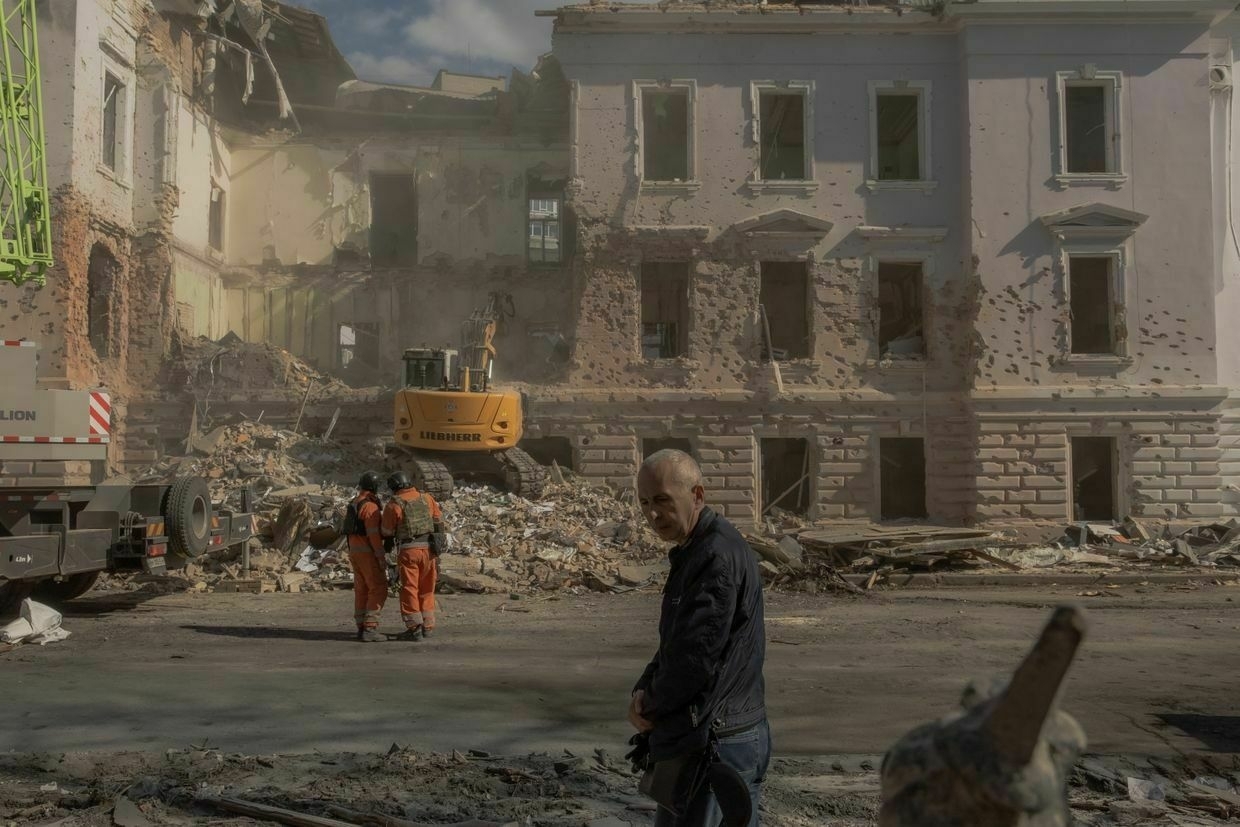
-
Kyiv’s fate is shaping how Tehran plays the nuclear game
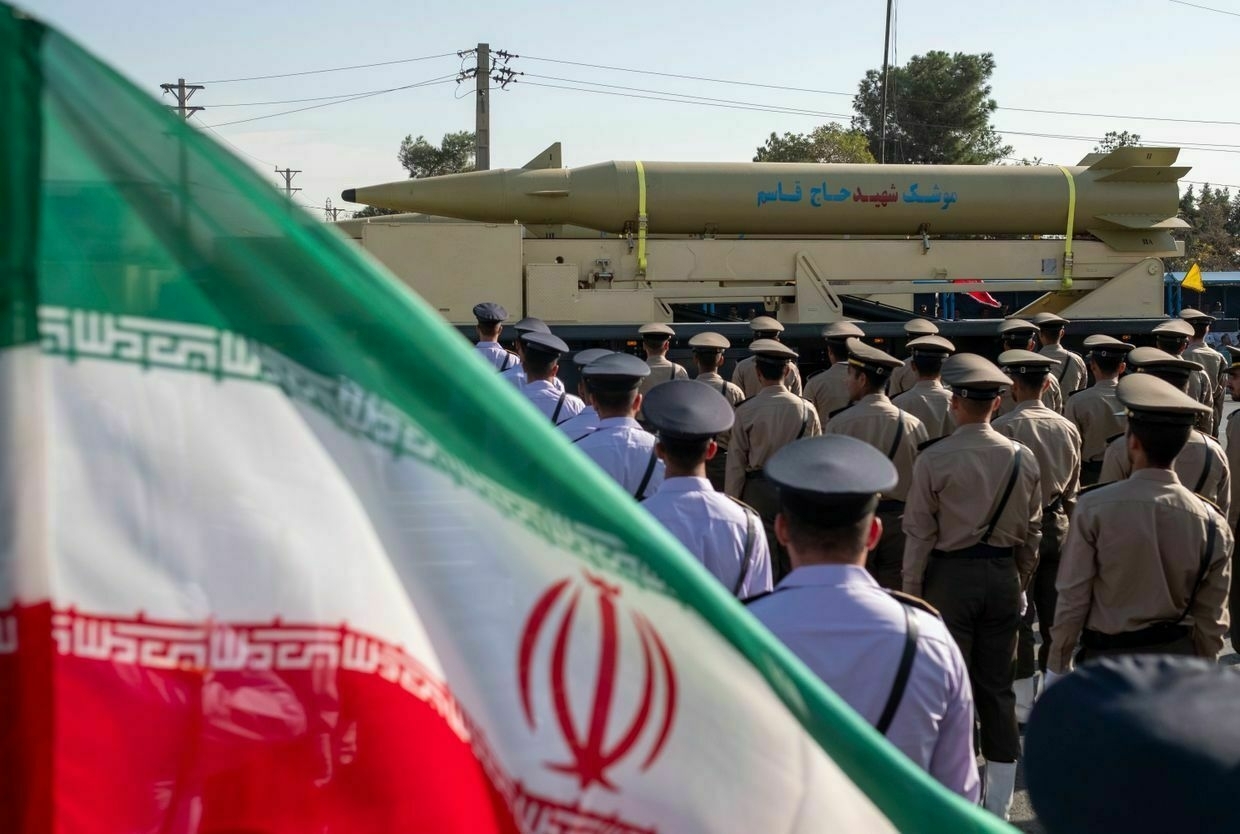
As the United States and Iran engage in renewed nuclear negotiations, the shadow of Ukraine looms large over Tehran’s strategic considerations. Recent indirect talks in Muscat, Oman — facilitated by Omani intermediaries — mark a significant diplomatic step. But Iran’s approach to these talks is deeply shaped by the lessons it draws from Ukraine’s experience with the West.
In 1994, Ukraine gave up its nuclear arsenal under the Budapest Memorandum, receiving assurances from the U.S., United Kingdom and Russia to respect its sovereignty. Yet the annexation of Crimea in 2014 and Russia’s full-scale invasion in 2022 have prompted Iranian strategists to question the reliability of such security guarantees. This context fuels Tehran’s skepticism toward Western promises and reinforces its insistence on maintaining a strong defense posture.
Iranian officials maintain that their nuclear program is intended for peaceful purposes, aiming to reassure the international community and gain relief from crippling sanctions. However, they draw a firm line when it comes to their ballistic missile capabilities and other defense assets, viewing them as vital deterrents against potential aggression. Ukraine’s fate serves as a stark reminder of the vulnerabilities of disarmament without enforceable security guarantees.
The Joint Comprehensive Plan of Action (JCPOA), signed in 2015 between Iran and the P5+1 nations— China, France, Germany, Russia, the U.K., and the U.S. — was a landmark deal to curb Iran’s nuclear activities in exchange for sanctions relief. Under the agreement, Iran limited uranium enrichment, reduced its stockpile of enriched uranium and allowed comprehensive inspections by the International Atomic Energy Agency (IAEA).
But in 2018, the U.S. unilaterally withdrew from the JCPOA under the Trump administration, reimposing severe economic sanctions on Iran. That move not only strained relations but also prompted Tehran to gradually reduce compliance with the deal. The collapse of the JCPOA remains a major point of contention, with Iran citing it as proof of the West’s unreliability in upholding international agreements.
The choice of Muscat as the venue for the current indirect talks is strategic as well as logistical. By using intermediaries, Iran aims to ensure any agreement gains broader international support and oversight. This reflects a desire to avoid the pitfalls Ukraine faced, where bilateral guarantees failed to prevent external aggression. Tehran believes that neutral third parties can add a layer of accountability and increase the chances of commitments being honored.
The indirect format also helps Iran manage internal political pressures. Direct engagement with the U.S. — especially given the hardline posture of Iran’s current leadership — could be politically untenable. Mediated talks provide a face-saving way to pursue diplomacy without appearing to capitulate to Western demands.
While Iran draws cautionary lessons from Ukraine, there are reciprocal insights for Kyiv. Ukraine’s at times inconsistent reliance on Western support highlights the importance of self-reliance and diversified alliances. Iran’s firm commitment to maintaining its defense capabilities — despite international pressure — underscores the strategic value of autonomy.
Iran’s engagement with non-Western powers such as Russia and China also reflects a multipolar foreign policy approach. Ukraine, traditionally aligned with the West, might consider broadening its diplomatic and economic ties to include countries in the Global South — such as India — to bolster resilience against external shocks.
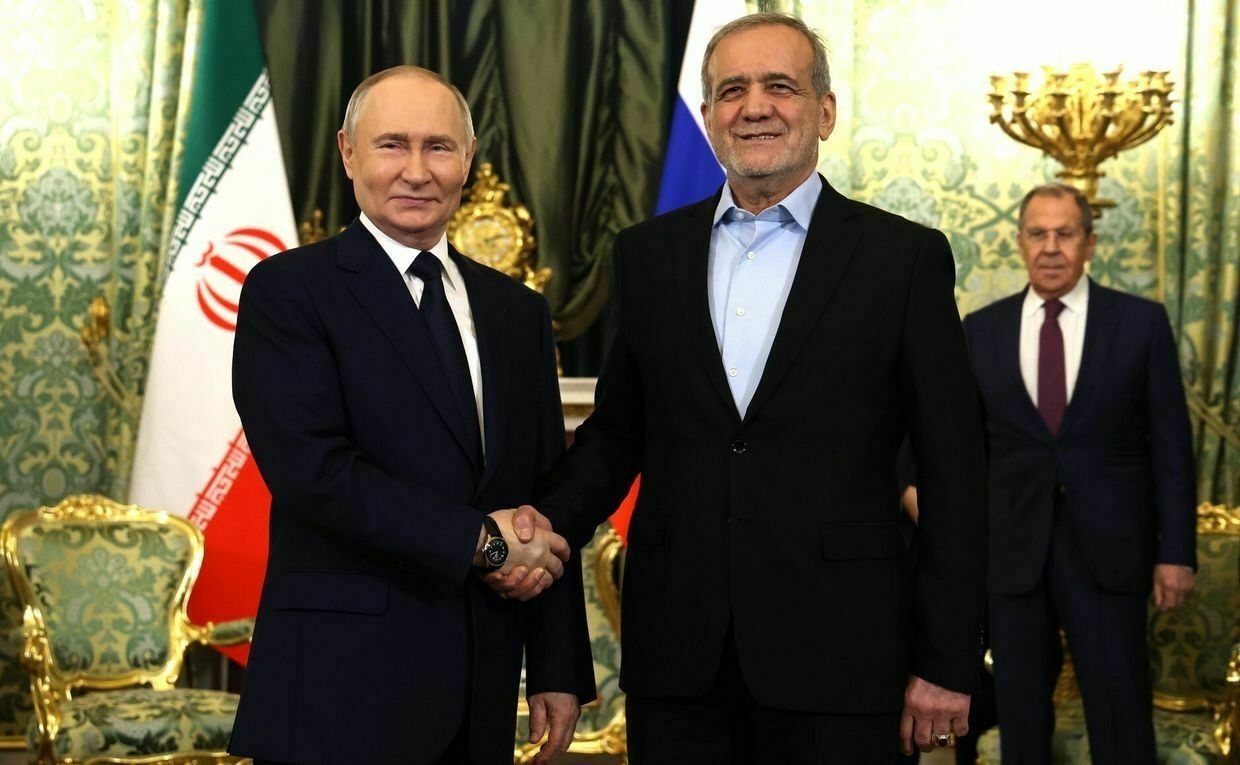
Russian President Vladimir Putin (L) meets Iranian President Masoud Pezeshkian (R) in Moscow, Russia, on Jan. 17, 2025. (Kremlin Press Office / Anadolu via Getty Images) As the next round of talks nears, both Washington and Tehran face significant hurdles. The U.S. aims to prevent Iran from developing nuclear weapons, while Iran demands sanctions relief and recognition of its right to peaceful nuclear energy. The Muscat channel has reopened diplomatic dialogue, but substantial gaps remain.
Meanwhile, Iran has intensified its development of missile and drone technologies — some of which have been deployed by Russia in Ukraine. The effectiveness of these systems in modern warfare reinforces Iran’s belief in their deterrent value. Iranian military officials argue that a strong missile arsenal is essential for maintaining a “balance of terror” and deterring adversaries. In their view, conventional forces alone may not be enough against technologically advanced opponents.
Iran’s participation in nuclear talks is tempered by deep-seated concerns over future threats. Tehran fears that a shift in global dynamics two decades from now could leave it vulnerable if current defense capabilities are compromised. This drives its insistence on agreements that include robust enforcement provisions and compliance mechanisms to guard against future betrayals. The fear of meeting Ukraine’s fate — relinquishing deterrents only to face aggression — looms large in its negotiating posture.
In this complex geopolitical landscape, the experiences of both Iran and Ukraine underscore the delicate balance between diplomacy, deterrence and national interest. As history has shown, the stakes are high — and the consequences of miscalculation can be profound.
Editor’s Note: The opinions expressed in the op-ed section are those of the authors and do not necessarily reflect the views of the Kyiv Independent.
Trump’s tariffs risk disaster while bipartisan Russia strategy offers hopeThere is unfortunately absolutely nothing good to say about the announcements U.S. President Donald Trump made during his recent “Liberation Day” event in the White House Rose Garden. Try as one might to “sane-wash” Trump’s economic policies, there is simply no coherent rationale for his supposedly…The Kyiv IndependentSimon Johnson
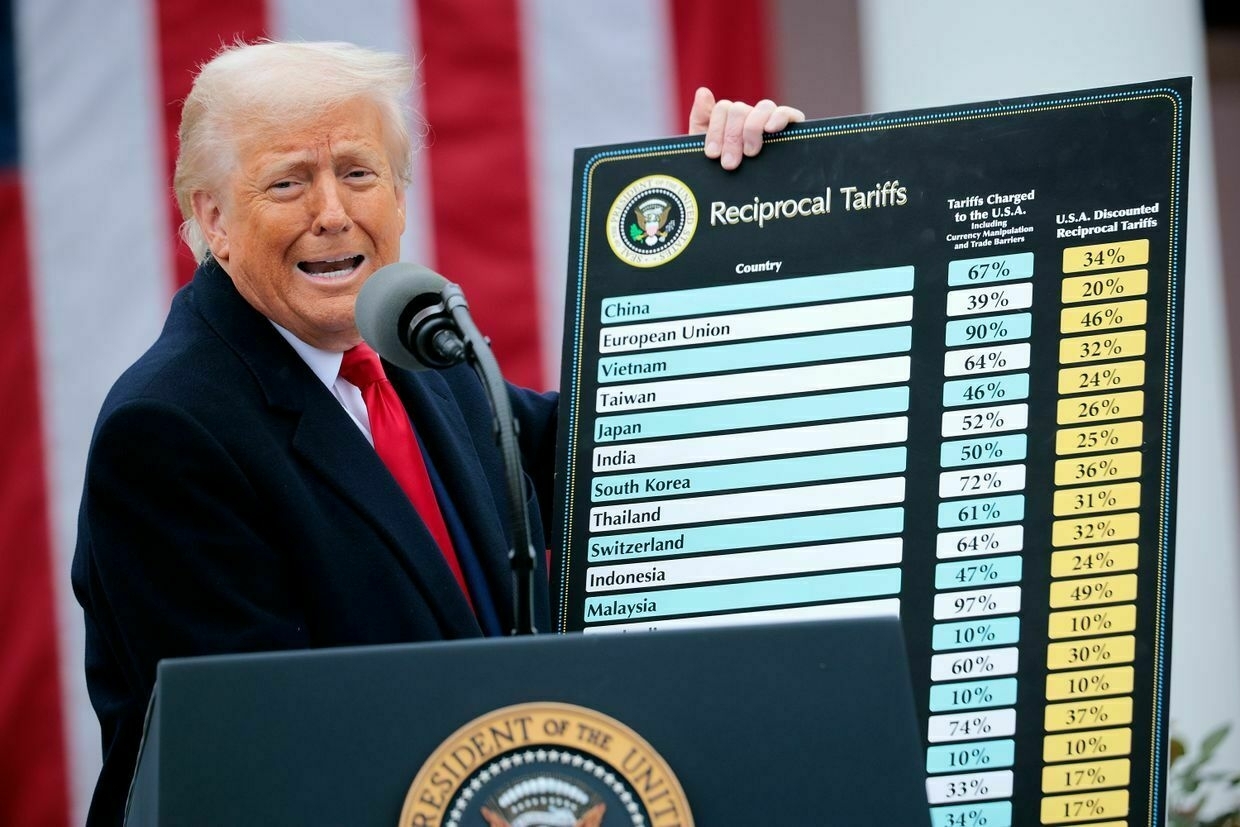
-
Zelensky proposes to use EU funds and frozen Russian assets to buy Patriot missiles amidst Trump's opposition
Ukrainian President Volodymyr Zelensky has suggested using EU financial resources and frozen Russian assets to purchase hundreds of Patriot missiles from the United States, reports Germany’s Bild, emphasizing that former U.S. President Donald Trump is unwilling to assist Kyiv, even if offered $50 billion from EU funds.
Zelensky’s proposal comes as the United States remains the sole producer of Patriot missiles. Prior to assuming office, Trump made it clear he preferred not to provide Ukraine with free assistance. The Ukrainian leader proposed a financial transaction whereby costly missiles, each priced at €5.5 million, would be purchased with an envisioned allocation of $50 billion (€44 billion). “Give us a package that includes air defense systems and other current tools, and we will pay for it,” Zelensky stated to Ukrainian media, detailing his offer.
However, the German publication notes that the current U.S. president is so absorbed in unfruitful negotiations with Russian President Vladimir Putin that he’s turning away potential defense profits from Ukraine. This is at a time when Ukraine desperately requires new air defense systems to prevent further civilian casualties, akin to the recent attacks at a playground in Kryvyi Rih and around a university in Sumy.
In response to a journalist's inquiry about the potential sale of anti-aircraft missiles to Ukraine, Trump told the White House press, “You know, he always wants to buy missiles. But you see, when you start a war, you should know whether you can win it. You can’t start a war against an enemy 20 times your size and expect someone to just hand over missiles.”
Trump’s remarks sparked irritation not just because of his continuous misidentification of the aggressors and victims in Russia's war of aggression, but also due to the economic inconsistency—arms exports would generate significant revenue for the U.S. economy. Washington’s cancellation caused an uproar in Ukraine, showcasing the U.S.'s alleged disinterest in "ending the bloodshed,” as Trump has often claimed. Instead, observers and activists explain, Trump’s policy only serves to fan the flames of aggression against Ukraine.
During the final months of his presidency, Joe Biden took significant steps to strengthen Ukraine’s critical munitions supply. The U.S. Department of Defense dispatched hundreds of thousands of artillery shells, thousands of rockets, and hundreds of armored vehicles, alongside a $1.25 billion additional military aid package approved by Biden in December 2024. This package allowed the continuation of U.S. arms supply, interrupted briefly in March by a harmful suspension instituted by Donald Trump. While this provided valuable time for Ukraine, their stockpile of U.S.-sourced munitions is close to depletion. The $1.25 billion aid package will soon be entirely used. The U.S. still retains several billion dollars available for further security assistance to Ukraine. However, since taking office, Trump hasn't approved any military aid packages for Ukraine and appears disinclined to change this stance in the future.
-
Trump's Ukraine peace push is really about business — and Putin knows it
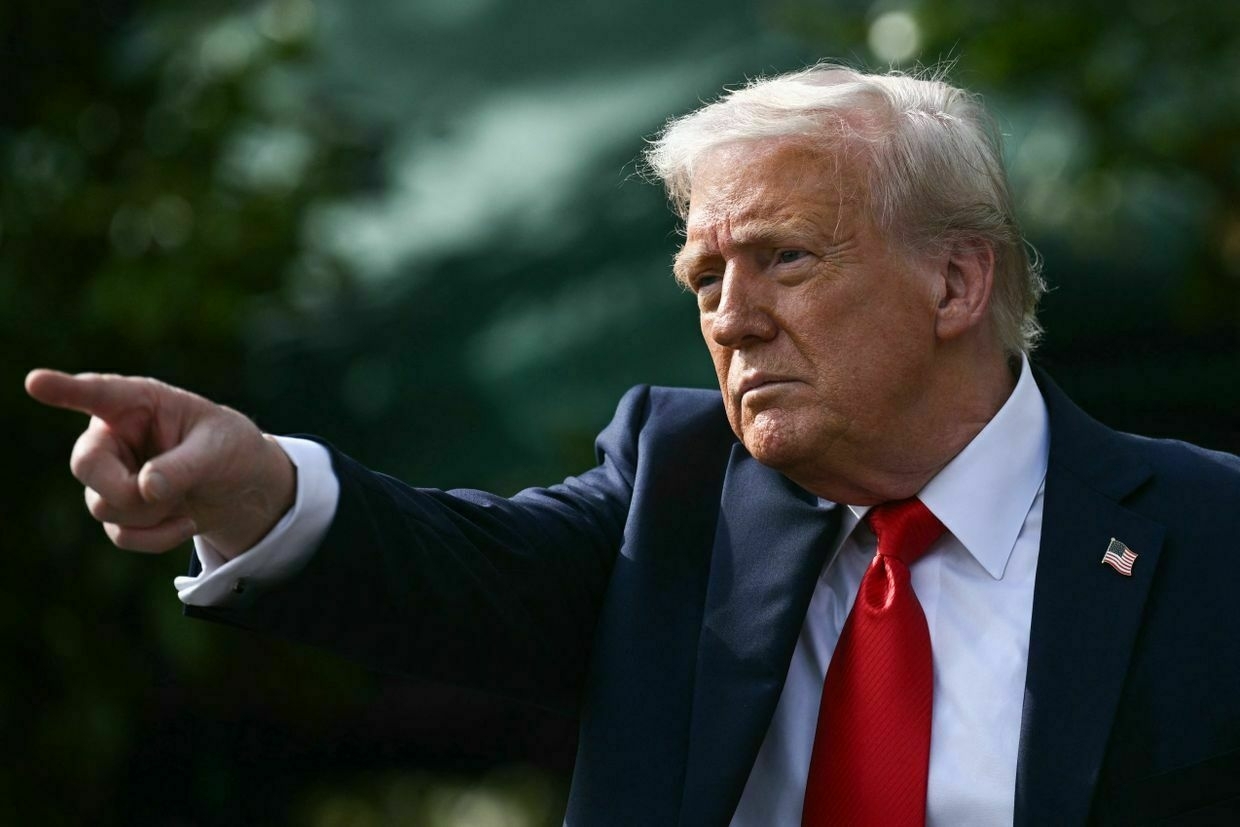
The American and Russian delegations that just met in Istanbul had made it clear that they were there to discuss the normalization of their diplomatic missions’ work, not the war in Ukraine. But such engagement is a clear corollary to U.S. President Donald Trump’s efforts to negotiate an end to the war. The problem is that, with the exception of Trump, who dreams of winning a Nobel Peace Prize, no party with a stake in the war — not Russia, not Ukraine, and not the European Union — wants to end the conflict now. No one is satisfied with their negotiating position, and everyone’s reputation is on the line.
Ukraine’s options are particularly unappealing. Despite its valiant resistance to Russia’s assault, Ukrainian President Volodymyr Zelensky is in no position to secure his desired outcomes: recovery of all territories occupied or annexed by Russia (including Crimea) and full NATO membership (with ironclad security guarantees). This was true under Trump’s predecessor, Joe Biden, but Trump has all but ruled out such demands, calling them impractical.
In fact, Trump is going so far as to push Zelensky to give the U.S. access to Ukraine’s rare-earth mineral deposits as compensation for America’s support during the war, without offering any security guarantees. Zelensky faces an unenviable choice: make major concessions to both the U.S. and Russia, or pour yet more Ukrainian blood and treasure into the illusory dream of “total victory.”
Europe is no more inclined than Ukraine to support a peace deal now. EU leaders have long contended that anything short of the total defeat of Russian President Vladimir Putin’s agenda to reclaim Russia’s sphere of influence in the former Soviet space would represent a threat to Europe, noting that even a weakened Russia would remain a spoiler. While they surely recognize by now that this outcome is virtually impossible, they would rather postpone the inevitable embarrassment of accepting a peace deal that grants Russia concessions.
Russia has less to lose from a peace agreement today, and Putin might be able to end the war without losing much face. The country has defied expectations by weathering harsh sanctions and other restrictions, and avoiding the destabilization of the regime. Moreover, though it has not fully annexed Donetsk, Kherson, Luhansk, or Zaporizhzhia, Russia has inflicted considerable territorial losses on Ukraine, which are unlikely to be fully reversed. Perhaps most important, Trump is so keen to strike a deal that he may well be willing to meet critical Russian demands, like keeping Ukraine out of NATO, especially if Putin softens his opposition to Ukraine remaining armed and is open to Ukraine’s accession to the EU.
But Putin is in no rush to get a peace agreement. To be sure, U.S. and Russian authorities have hailed bilateral peace talks — including meetings in Riyadh, Saudi Arabia, in February and March — as a diplomatic breakthrough. But statements from Russia’s representatives — in particular, Sergey Beseda, an adviser to the head of Russia’s Federal Security Service (FSB), and Grigory Karasin, chair of the Federation Council’s international affairs committee — suggest that there has been little progress toward an agreement.
One reason for this may be that neither Ukraine nor the EU is at the table, which limits what Trump can offer. Perhaps more important, Putin is still trying to work out where that limit is. This explains why, as part of a new maritime security deal in the Black Sea, Putin has demanded the lifting of sanctions and restrictions against producers and exporters of agricultural goods and against some financial institutions, including the state-owned agricultural bank Rosselkhozbank. Only when these conditions are met — and the Kremlin has a clearer sense of how far Trump will go to fulfill his peacemaking ambitions — can a ceasefire be negotiated.
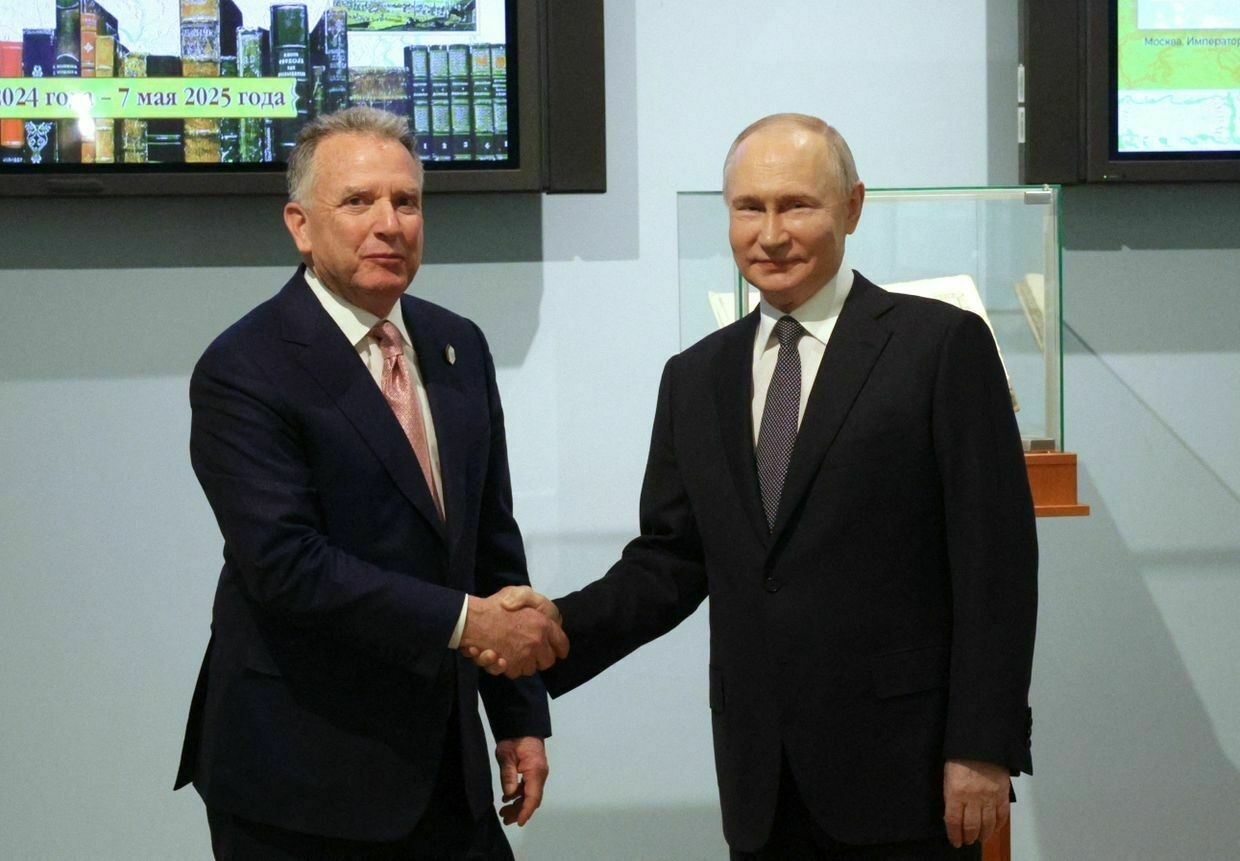
Russia’s President Vladimir Putin meets US President Trump’s envoy Steve Witkoff in St. Petersburg, Russia on April 11, 2025. (Gavriil Grigorov/Pool/AFP via Getty Images) Putin is taking other steps to set Russia up for success in negotiations with the U.S. Notably, he recently sent his “investment envoy” Kirill Dmitriev — the Stanford-educated former Goldman Sachs investment banker who directs Russia’s Direct Investment Fund — to the U.S. to highlight the economic benefits of renewed bilateral cooperation. Beyond praising Trump for supposedly averting World War III, Dmitriev offered an enticing vision of U.S. access to Russian Arctic resources and rare-earth minerals, as well as joint Mars and Moon missions.
While the meetings did not produce any concrete advances, Dmitriev proclaimed that the two sides had taken “three steps forward” toward better relations. What he really meant may well be that U.S. leaders are now more motivated to seize economic and financial opportunities in Russia and overcome the hurdle that the Ukraine war represents. Less than a week later, Steve Witkoff, the Trump administration’s de facto envoy to the Russian president, appeared in Saint Petersburg for a meeting with Dmitriev, and reportedly with Putin.
Those opportunities might be tailored for Trump himself. After all, Trump is a businessman first, and I know his longstanding ambition to establish a presence in Moscow firsthand. During a chance encounter in 1996, he told me that he wanted to bring the Miss Universe Pageant to Russia (a goal he achieved in 2013) and build a Trump Tower in Moscow (a vision he has yet to realize). Might the Kremlin offer the U.S. president prized Red Square real estate — or some other lucrative business deal — in exchange for sanctions relief?
For now, Trump says he is “pi**ed off” at Putin for not being more amenable to his administration’s ceasefire proposals, and he is threatening to impose yet more sanctions. But, by leveraging the right mix of well-calibrated demands and tantalizing offers, Putin may be able to position himself as the one calling the shots. Given this, whatever unfolds in these rapid-succession meetings will probably mean less than what follows: Karasin and Beseda reciting, yet again, the Kremlin’s rigid demands, or Dmitriev waving economic enticements before Trump and his cadre in Washington.
Editor’s Note: The opinions expressed in the op-ed section are those of the authors and do not necessarily reflect the views of the Kyiv Independent.
Hockey celebrates Ovechkin, but Putin is the real winnerAlexander Ovechkin has become the greatest goal scorer in National Hockey League (NHL) history — an extraordinary accomplishment that cements his legacy as one of hockey’s most influential figures. For fans around the world, the Washington Capitals’ No. 8 stands as a symbol of perseverance, dedicati…The Kyiv IndependentAdam Sybera

-
Tariffs destroyed Ukraine’s automotive industry. Is the U.S. next?
Editor’s Note:
We turn two years old in just over one week.
Will you support our ongoing subscription drive by upgrading?We look past the headlines to tell powerful, human stories from the heart of the war. Support journalism that digs deeper and helps you truly understand the lives of free people.
Yurii Pelykh has been building Ukrainian cars all his life, believing that one day they could compete with foreign cars.
However, when the government imposed import duties to protect domestic manufacturers, his hopes were dashed. The workshops gradually closed, his salary decreased, and the job he loved became defunct.
After more than 20 years at the plant, Yurii had to leave – not because he wanted to, but because there was nothing left to stay for.
In the early 1990s, Ukraine imposed high tariffs on imported cars to protect domestic producers. However, rather than fostering a thriving auto industry, the country faced stagnation. Ultimately, Ukrainians were forced to pay inflated prices for imported cars [Editor’s note: The Counteroffensive’s evacuation car in Kyiv is an almost two decades-old Mitsubishi].
A similar economic model is now being implemented in the United States. The Trump administration has raised tariffs on foreign cars to 25 percent to curb the foreign competition. Ukraine's experience should serve as a warning. In an era of global competition, protecting domestic producers by taxing imports can backfire, leading to stagnation and higher consumer prices everywhere.
"This will not end well. I think the whole world is in crisis: China has already retaliated with 125% tariffs [on the U.S.] and will not lift them," Yurii told The Counteroffensive.
Yurii Pelykh, 52, joined the Zaporizhzhia Automobile Building Plant, a legend of the Ukrainian automobile industry, as a process engineer in 1995, immediately after graduating from university. At that time, the plant produced just two cars: the Tavria and the Slavuta.
They were cheap and easy to repair. The Tavria, named after the historical name of the Crimean peninsula, was a hatchback; and the Slavuta, whose name comes from the Slavuta River, which is the ancient name of the Southern Bug River in southwestern Ukraine, was an extended version with a sedan body.
For many Ukrainians, these cars became their first personal vehicles in independent Ukraine.
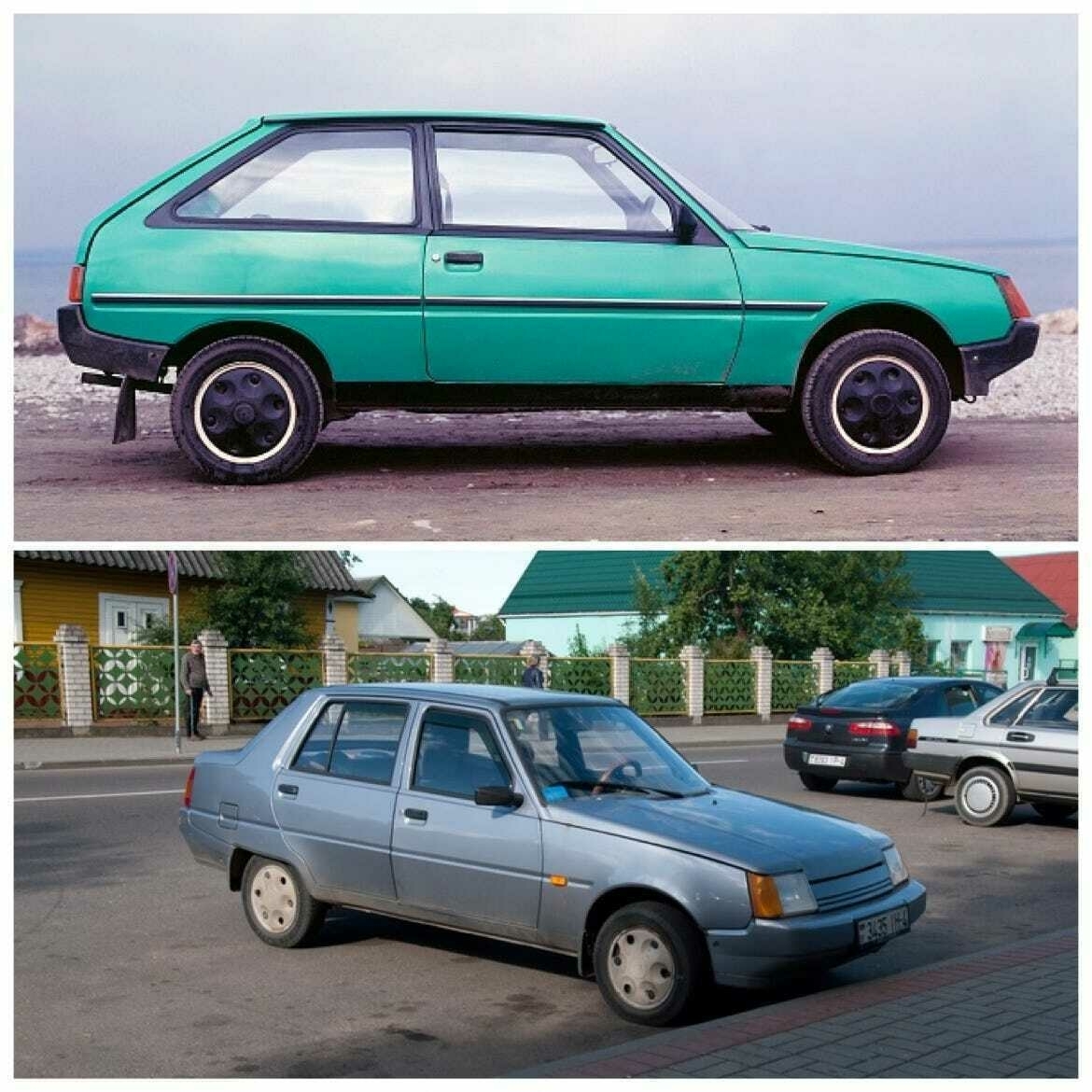
Top: 1988 Zaz 1102 Tavria. Photo by National Motor Museum/Heritage Images via Getty Images. Bottom: Car ZAZ-1103 "Slavuta" at Pushkin street. Photo by Getty Images After the collapse of the USSR, the plant started to decline: first because of the economic crisis of the early 1990s and then because of the influx of foreign cars. To support domestic producers, Ukraine introduced a 25 percent tariff on imported cars in 1991. ZAZ itself lobbied for the idea of import duties.
"I think it initially protected our domestic market. Thanks to these tariffs, there was a great demand for our cars," Yurii said.
Working at the plant was challenging yet very interesting. Initially, cars were produced in sufficient quantities; Yurii was promoted, and his salary increased, along with those of many colleagues. His standard of living improved, especially since Ukrainian cars at that time were of high quality and people wanted to buy them.
"It was very interesting to work... I was proud of our production, of the plant. My work opened up new opportunities," Yurii said.
However, this import policy did not prove to be a long-term solution, said Veronika Movchan, the head of the Center for Economic Research.
According to Veronika, in addition to the economic crisis of the 1990s, which made it harder for people to buy things, the lack of competitive Ukrainian cars was significant. Domestic manufacturers struggled to deliver the necessary quality and technological standards to compete with foreign brands.
"The introduction of these duties could have given us a real opportunity to rebuild and start working in a new way. However, we also needed to invest in the development of the industry. But this was never done in Ukraine," Oleksandr Strohanov, former director of the Lviv Bus Plant, told The Counteroffensive.
As a result, even after introducing protective tariffs, the Ukrainian automotive industry could not regain its position in the market. As Ukraine began to increase imports of safer and more efficient foreign cars, people began to find the Ukrainian Tavria and Slavuta expensive and outdated.
"To compete, we need to develop. We had developed production to a certain level, but new models had to appear. This is what always happens in the car market. We developed a successful model, but it has to be modernized after three years. For us, nothing changed," Yurii said.
Even Yurii himself decided not to buy a ZAZ car. He says he was saving for an apartment, but even after he bought it, he never purchased a Ukrainian car.
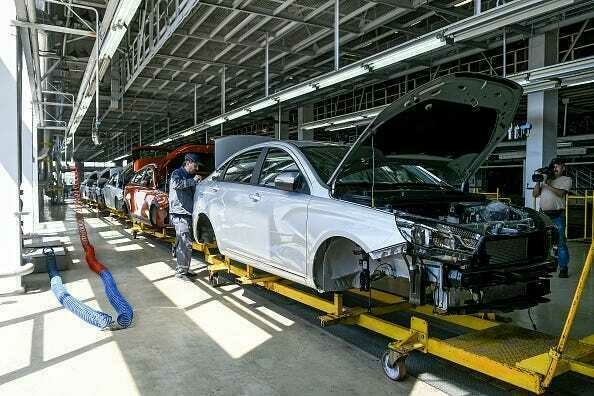
Cars on the production line at the Zaporizhzhia Automobile Building Plant, Zaporizhzhia, southeastern Ukraine, August 4, 2021. (Photo credit should read Dmytro Smolyenko/ Ukrinform/Future Publishing via Getty Images) 2007, the last year before the global economic crisis, was the best year for ZAZ. At that time, the plant produced the largest number of cars in one year — more than 280,000. But after that, Yurii said, the situation became more complicated every year.
By 2016, ZAZ only produced 500 cars.
It was a real shock for Yurii. He loved his job at the factory, but conditions were deteriorating. Yurii states that his colleagues were eager to work and develop new cars, but at that moment, there was insufficient funding for such initiatives.
"It was painful... I had to lay off people. I had 20 people working and I had to dismiss 5. It was unpleasant and difficult. Things got sadder and sadder," Yurii said.
Before Russia’s 2014 invasion, the plant produced cars for Ukraine’s domestic market and for export, mainly to countries in the former Soviet Union, particularly Russia. After the war began, cooperation with Moscow was suspended.
"There was no alternative. Europe did not accept us. Because there are certain standards there, including toxicity standards [which Ukraine did not meet]," Yurii said.
Yurii felt the impact of the tariffs on the plant. As the Ukrainian automotive industry did not create new development opportunities, the plant eventually could not pay Yurii because it lacked sufficient funds.
He was not fired but demoted from his management position. In addition to the fact that his standard of living dropped due to a decrease in his salary, it was also a decrease in his status.
"A step back, not forward," Yurii said.
Finally, in 2017, Yurii could no longer tolerate the situation and quit to seek a better job. Although he once took pride in his work and earned a good salary, by the end of his career, he had neither. Now, he makes car mufflers at another factory, which are shipped to Europe.
"The plant used to work around the clock. And what happened later was no longer work[ing].... So I wanted to prove to myself that I could do more and better," Yurii said.
In 2025, the United States imposed new tariffs on imported cars. Veronika Movchan and Serhii Sukhovskyi, editor-in-chief of the information and analytical group Autoconsulting, said the situation could be even worse for the United States than it was in Ukraine.
Ukrainian manufacturers lobbied for tariffs because of the domestic auto industry’s lack of competitiveness. But the American auto industry is very competitive. The United States has a strong domestic market and a developed auto industry. For decades, it has built global supply chains for efficiency and profit. Now, the Trump administration is effectively severing critical international ties.
"Cars will become much more expensive, which is bad for the U.S. For them, a car is a key element of life. Almost everyone drives to work. So if cars become more expensive, this is a critical issue for every family," Movchan said.
A recent study from the Center for Automotive Research estimates that the 25% auto tariffs introduced by President Donald Trump in early April will cost U.S. automakers around $108 billion in 2025.
Imposing tariffs on imported cars is popular among the public. Yet, Ukraine's bitter experience shows that everyone loses — both domestic producers and importers.
Yurii is convinced that the issue is approaching a catastrophe, leading him to believe that the United States should lift the tariffs currently in place.
In the best years, the Ukrainian car market had 623,000 new cars and was Europe's No. 7 car market, according to Autoconsulting. Today, it is almost zero. At present, there are 10 automobile factories in Ukraine. However, none produce their own cars: some assemble foreign cars, while most produce buses, school buses, trolleybuses, or trucks.
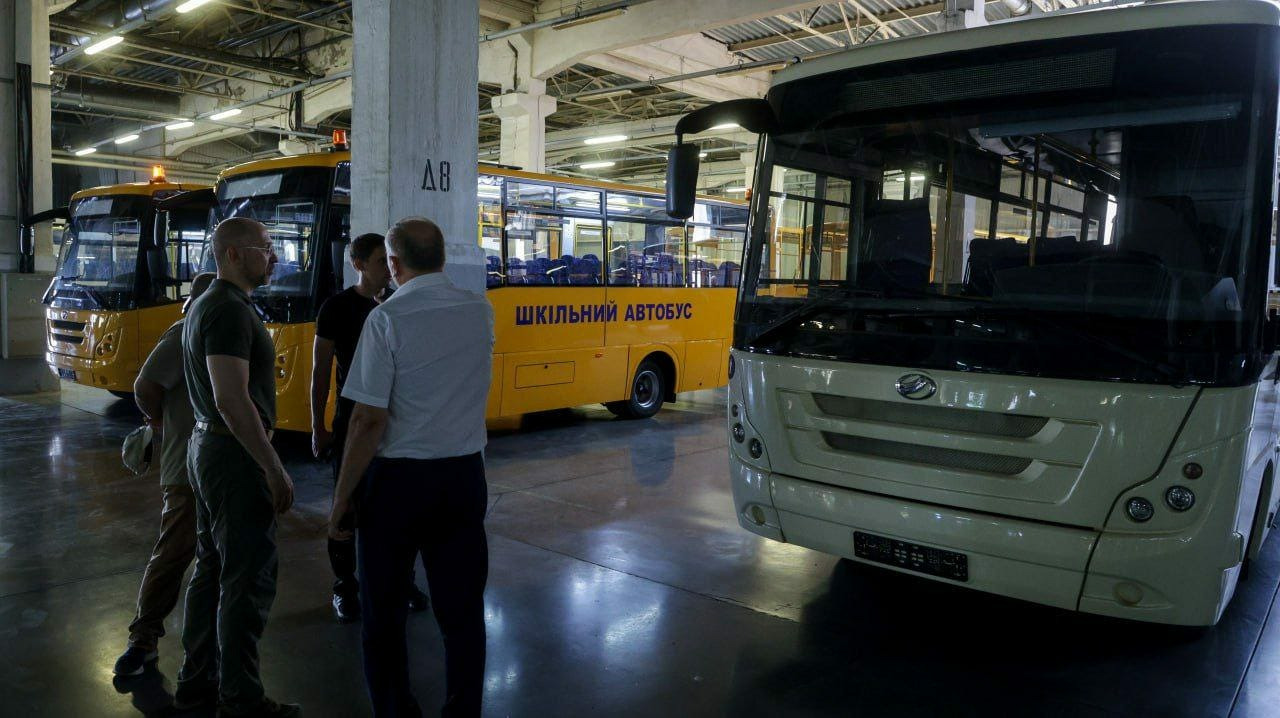
School buses manufactured by ZAZ, July 2024. Photo: Telegram/Denys Shmuhal The chances of reviving Ukrainian car production are rather slim. According to Movchan, Ukraine's only hope is to start producing trucks for the army, which Ukraine needs now.
Yurii Pelykh fondly remembers his work at the Zaporizhzhya Automobile Building Plant.
Sometimes, he misses it, but he does not want to go back there because it is a stage of his life that has already passed.
In this time of great uncertainty — and unstable American support — it means that the situation on the ground is very dangerous. Your contributions help us get the body armor, medical gear, and supplies we need to stay safe.
Show your support by contributing to our tip jar - funds go towards keeping us safe and ensuring our work continues.
NEWS OF THE DAY:
Good morning to readers; Kyiv remains in Ukrainian hands.
TRUMP LOWERS DEMANDS FROM KYIV: The U.S. has softened its demands for compensation over aid provided by the Biden administration, Bloomberg reported.
Earlier, Trump estimated the American military aid at $300 billion. However, the amount has now been reduced to $100 billion. This change was agreed upon during last week's negotiations regarding a potential minerals agreement.
The latest version of the agreement includes concessions from Kyiv. For example, the United States will have the first right to receive profits allocated to a special investment fund for reconstruction. Simultaneously, this estimate aligns more closely with Ukraine's position, which assesses American aid to be around $90 billion.
KYIV STRIKES RUSSIAN BRIGADE BEHIND SUMY ATTACK: Ukrainian drones have hit the Russian city of Shuya, home to the 112th missile brigade. The Kyiv Independent reported.
A day earlier, Ukraine's General Staff reported an attack on the 448th Missile Brigade in the Kursk region. These two brigades were responsible for the missile attack on the city of Sumy on Palm Sunday, the Ukrainian government assesses. The attack killed 35 civilians.
N. KOREAN MILITARY MAY BE USED IN NEW OFFENSIVE IN UKRAINE: Ukrainian intelligence does not rule out the possibility that the Russians will employ the North Korean military in their offensive against the Sumy and Kharkiv regions, spokesman Andrii Cherniak told NHK. Previously, the North Korean military fought only in the Kursk region of Russia.
He claims that North Korea's losses have now reached approximately 5,000. However, another 6,000 soldiers remain in Kursk and may continue to fight. Cherniak reports that North Korean troops in Kursk intend to bring the tactics of modern warfare back home and teach them to other soldiers in their country, which could pose a threat to the entire Asia-Pacific region.
DOG OF WAR:
Today’s Dog of War is Sam, Liza’s dog. Even though he’s already 10 years old, he’s very energetic, loves running, and adores being petted.
Stay safe out there.
Best,
Artem -
'Significant progress' — Ukraine, US to conclude minerals deal in 'near future,' Deputy PM says
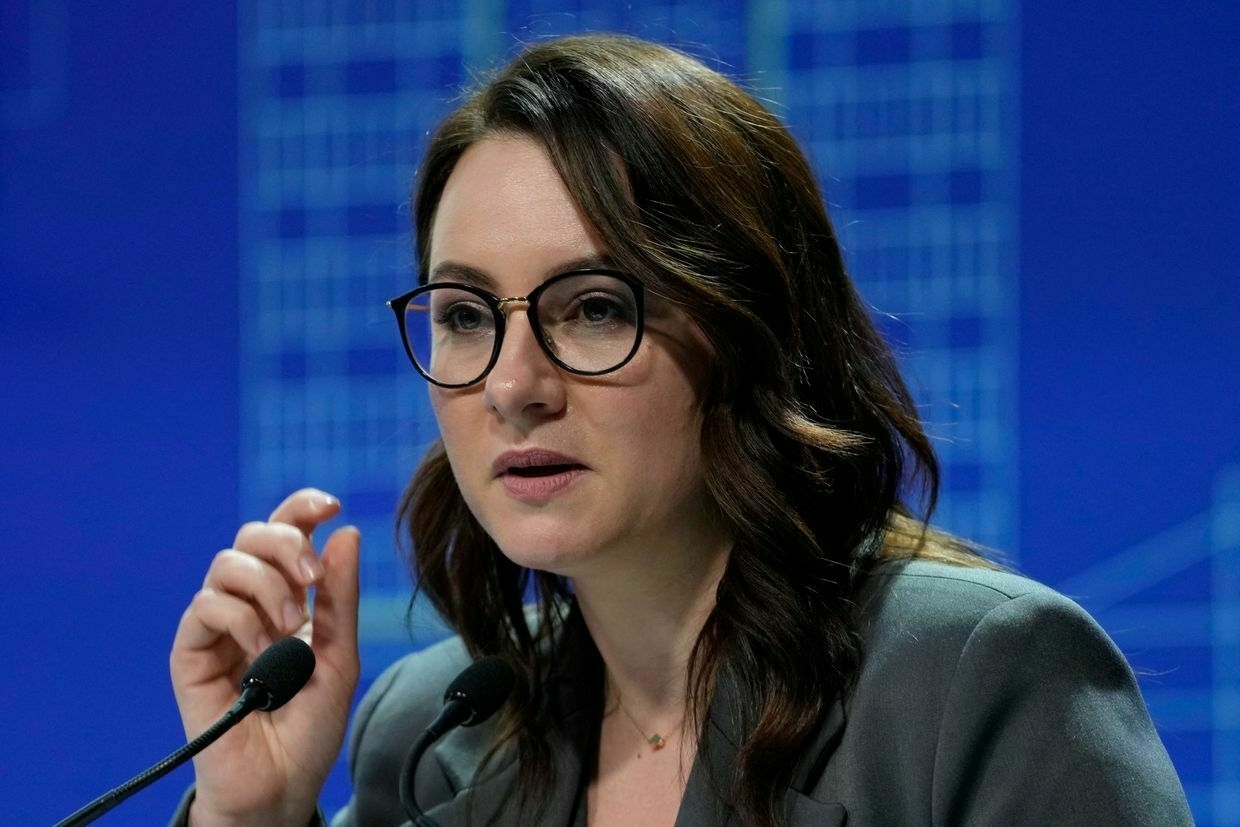
U.S. and Ukrainian negotiators have made “significant progress” in talks on a minerals deal, which will be concluded in the “near future,” Deputy Prime Minister and Economy Minister Yuliia Svyrydenko said on April 16.
“Our technical teams have worked diligently on the agreement. We’ve made significant progress, and the legal teams have ensured the appropriate emphasis in the draft. I extend my thanks to the negotiators on both sides,” Svyrydenko said on Facebook.
The statement follows consultations between U.S. and Ukrainian delegates in Washington on April 11 and 12, which were meant to hash out details of the long-debated deal on Ukraine’s natural wealth.
While initial reporting indicated the talks began in an “antagonistic atmosphere,” President Volodymyr Zelensky later said the round of discussions concluded in a “positive mood."
“We have now agreed with the U.S. side to affirm this positive development by a relevant memorandum of intent — we are preparing a formal conclusion of the deal in the near future,” the deputy prime minister noted.
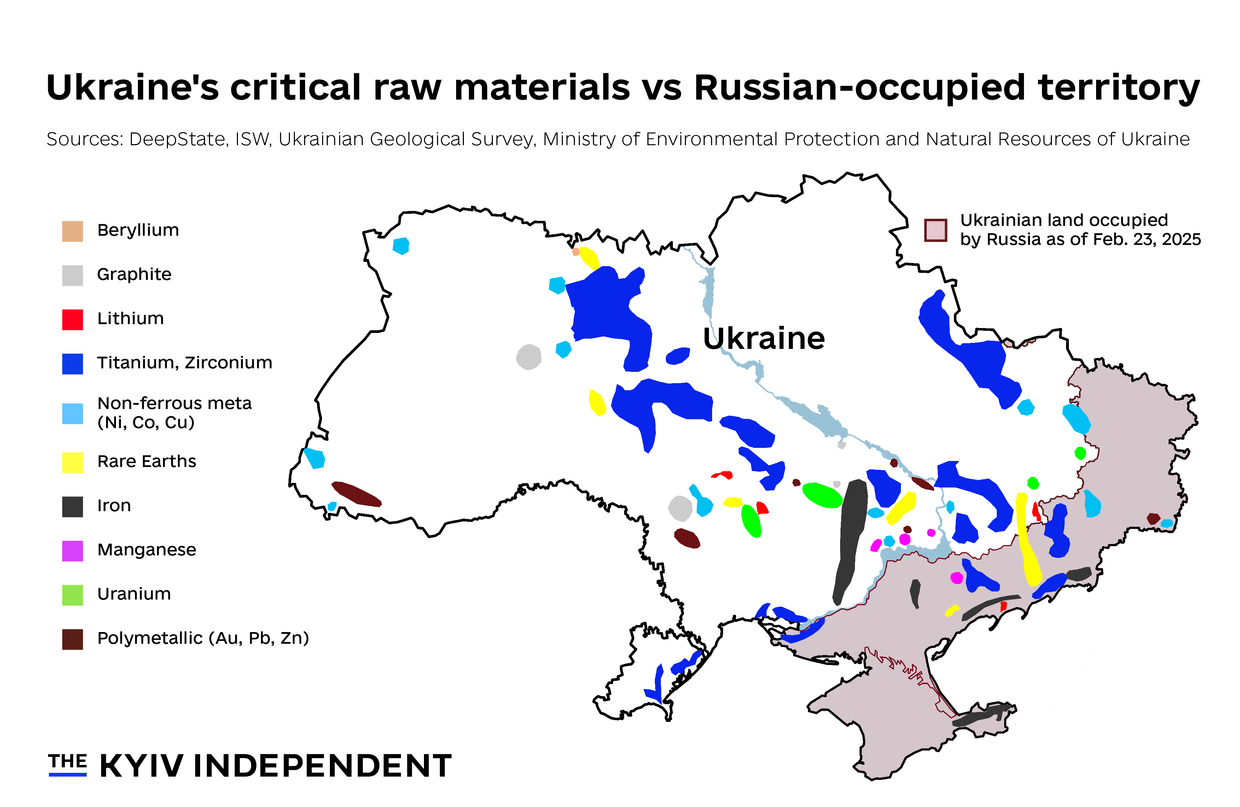
A map showing the location of critical raw materials in Ukraine. (The Kyiv Independent) According to earlier reporting, the U.S. proposal would grant extensive control to a joint investment fund managed by Washington, with no offer of security guarantees in return. The Trump administration has framed the deal as a way to recoup the billions of dollars in military and financial aid provided to Ukraine since the start of Russia’s full-scale invasion in 2022.
Bloomberg reported earlier on April 16 that the U.S. has softened its “maximalist” demands, lowering the payback it seeks for the provided aid from $300 billion to $100 billion. While the latter sum is closer to Kyiv’s estimates of the supplied assistance, President Volodymyr Zelensky has stressed that Ukraine does not see the aid sent by the Biden administration as debt.
Speaking to Bloomberg, U.S. Treasury Secretary Scott Bessent nevertheless said that the negotiators are “very close” and the deal could be finalized as early as this week.
“The teams will continue to work on the details, a lot has been worked out,” Svyrydenko said.
“The agreement will be subject to ratification by the Ukrainian parliament and will provide opportunities for investment and development in Ukraine and ensure conditions for tangible economic growth both in Ukraine and the U.S."
The original framework agreement was expected to be signed during Zelensky’s visit to Washington on Feb. 28, but the plan fell apart following a heated Oval Office dispute with U.S. President Donald Trump and Vice President JD Vance. Zelensky left without finalizing the deal.
Ukraine has since hired the American-British law firm Hogan Lovells to advise on the negotiations.
Ukraine’s long-suffering aerospace giants look to Europe to break free from Russian orbitWhere the Donbas meets the Dnipro River, the USSR built out a dense range of massive factories, using the local coal and metal reserves to smelt, weld, and cast the heaviest of machinery — and weaponry — for the whole of the Soviet Union. One of these is Pivdenmash, formerly known byThe Kyiv IndependentKollen Post
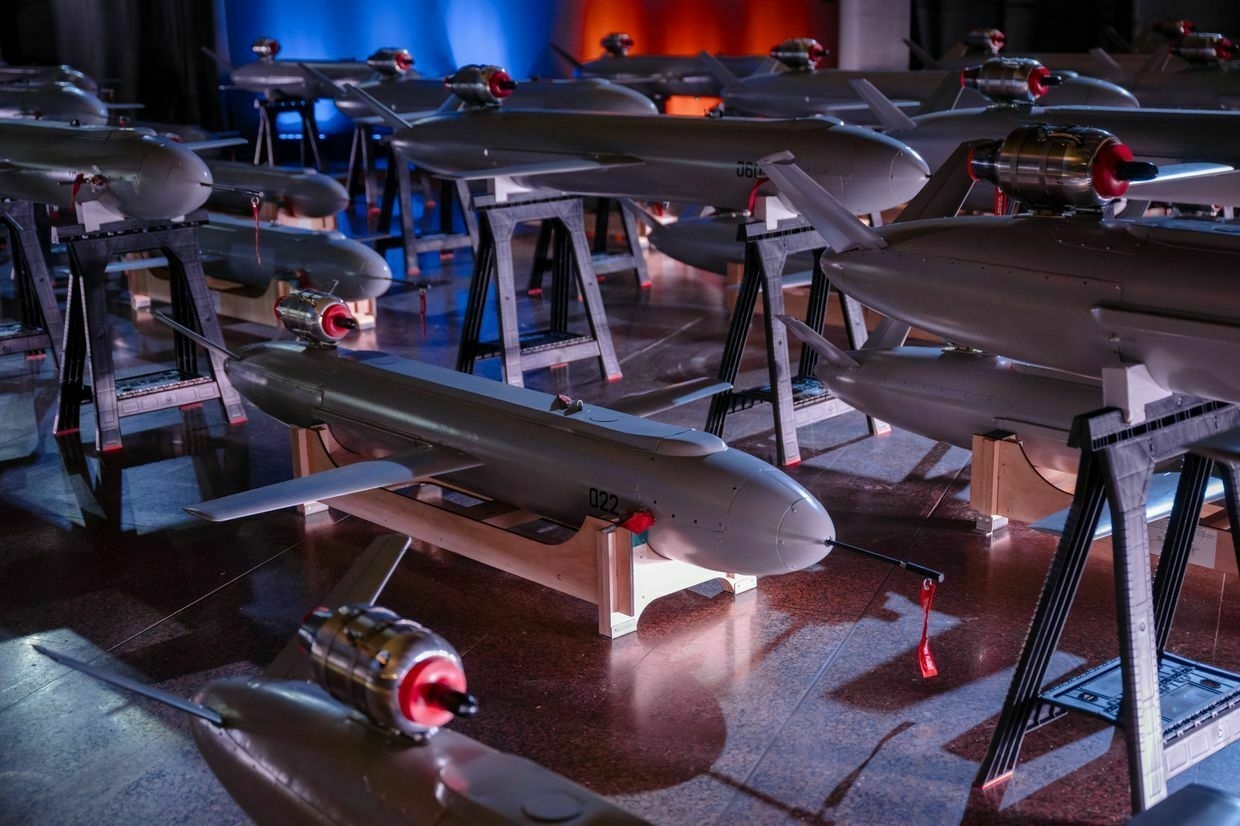
-
Denmark to send unarmed soldiers to Ukraine for drone warfare training
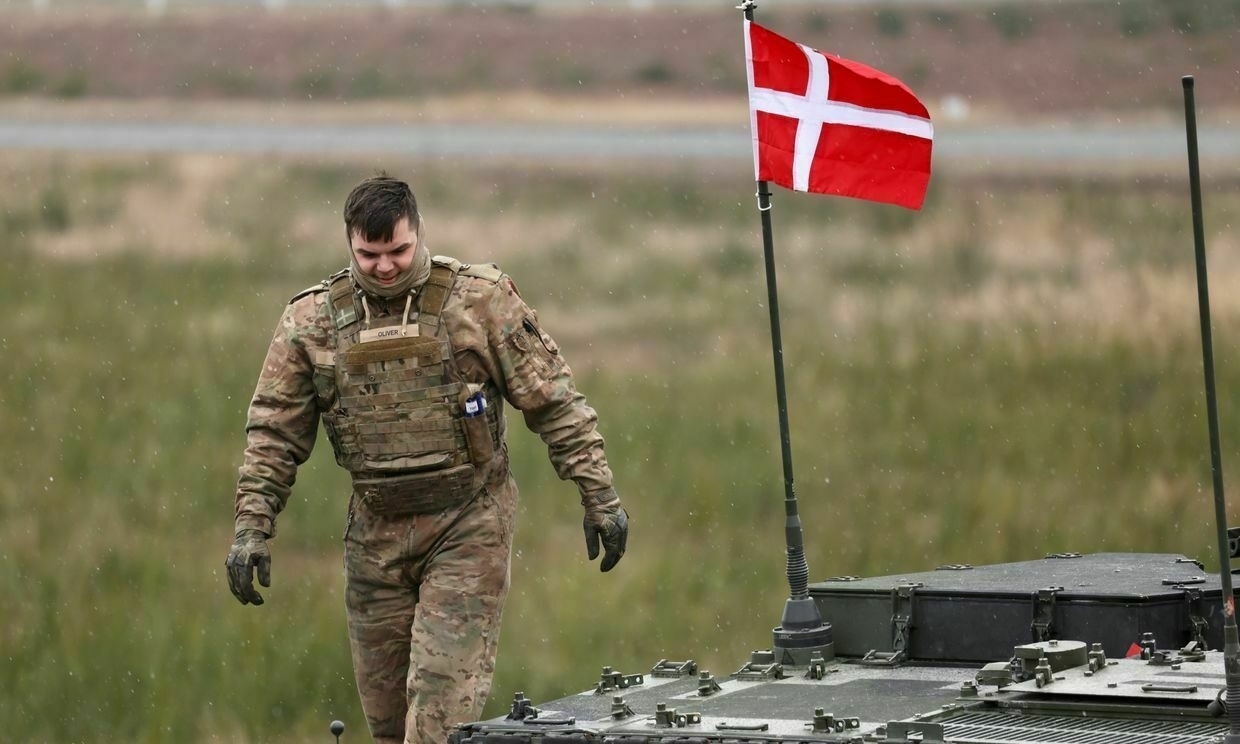
The Danish Armed Forces plan to send unarmed troops to Ukraine for short-term training courses to study the country’s drone warfare tactics, Major General Peter Boysen, Denmark’s commander-in-chief, told state broadcaster TV 2 on April 16.
While several NATO countries have trained Ukrainian forces abroad, no official reports have confirmed the presence of foreign troops inside Ukraine for training purposes.
The courses, expected to begin as early as this summer, will take place at training centers in western Ukraine and will not involve direct combat.
“We’re sending some teams down to see what experiences the Ukrainians have had — first-hand,” Boysen said. “They are not going there to actively participate in the war."
Boysen, who has visited Ukraine twice in recent months, said the initiative is being launched at the invitation of Ukrainian Commander-in-Chief Oleksandr Syrskyi.
“In the 42 years I have been in the Armed Forces, I have not experienced things moving as fast as they are right now,” Boysen said, referring to advances in unmanned systems and combat tactics driven by Ukraine’s experience with drone warfare.
Both Ukraine and Russia have come to rely heavily on drones for reconnaissance, artillery spotting, and targeted attacks. Denmark sees the conflict as a live testbed for modern warfare.
The training program will involve teams from different Danish military regiments. Courses will last one to two weeks and be conducted far from the front line, possibly near Lviv.
Boysen emphasized that Ukraine has robust air raid warning systems and shelters, saying, "I've spent time in one of them in Kyiv myself."
The move drew sharp criticism from the Russian Embassy in Copenhagen. Russian Ambassador Vladimir Barbin called the decision a provocation, warning it would "drag Denmark deeper and deeper into the conflict in Ukraine."
"(F)acilities, including headquarters, training and education centers, as well as locations of military personnel and military equipment, both deep inside Ukrainian territory and on the front line, are a legitimate target for the Russian Armed Forces," Barbin said.
Separately, European allies are discussing plans to deploy a "reassurance force" in Ukraine after a potential ceasefire to secure Ukrainian strategic facilities in the rear. Copenhagen signaled interest in taking part in the effort.
Denmark has been a key backer of Ukraine since the start of Russia's full-scale invasion in 2022. In February 2024, Copenhagen signed a 10-year bilateral security agreement with Kyiv, pledging long-term defense cooperation until Ukraine secures NATO membership.
Trump officials ‘fed up’ with Europe’s efforts to strengthen Ukraine, Economist reportsThe Trump administration officials are dissatisfied with European countries’ ongoing support for Ukraine, underscoring the growing rift between Washington and Europe, the Economist reported on April 15, citing undisclosed diplomatic sources.The Kyiv IndependentMartin Fornusek
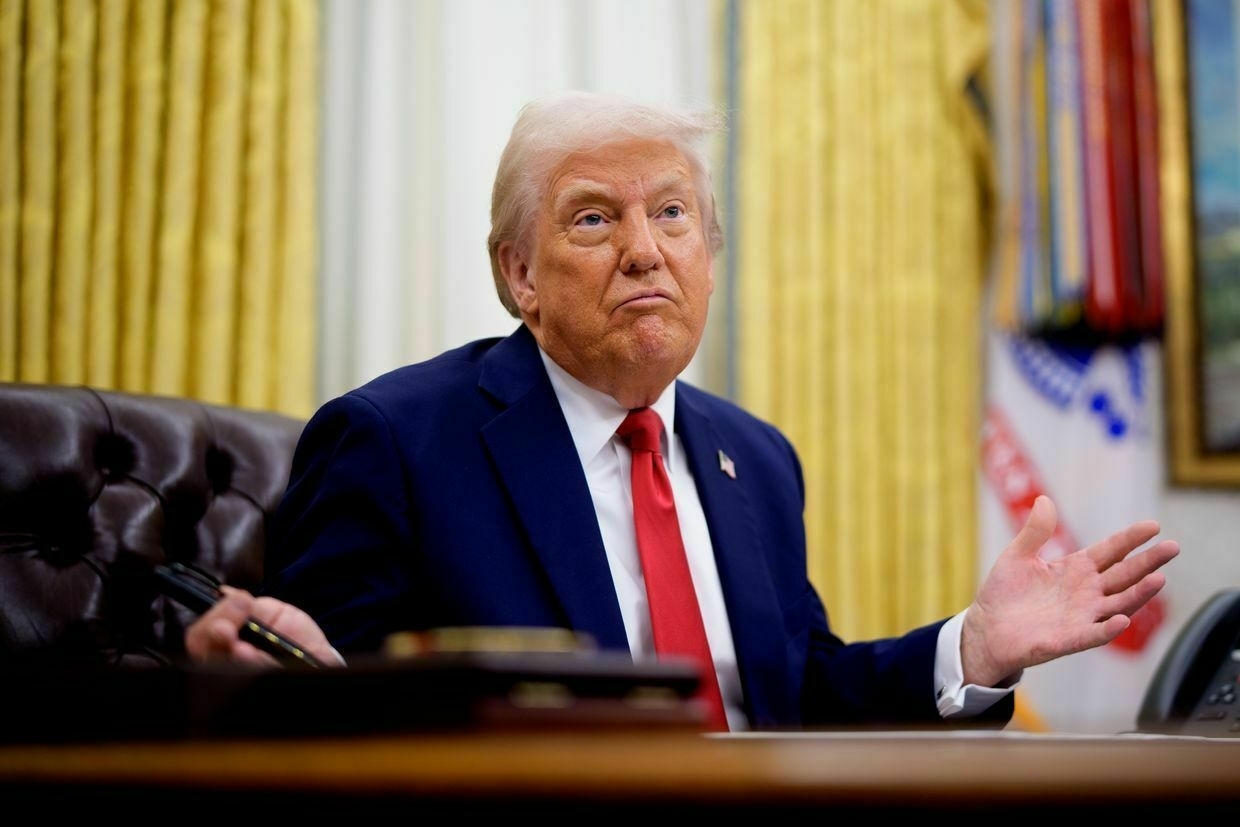
-
Italy transfers $28 million to restore Ukraine's energy infrastructure
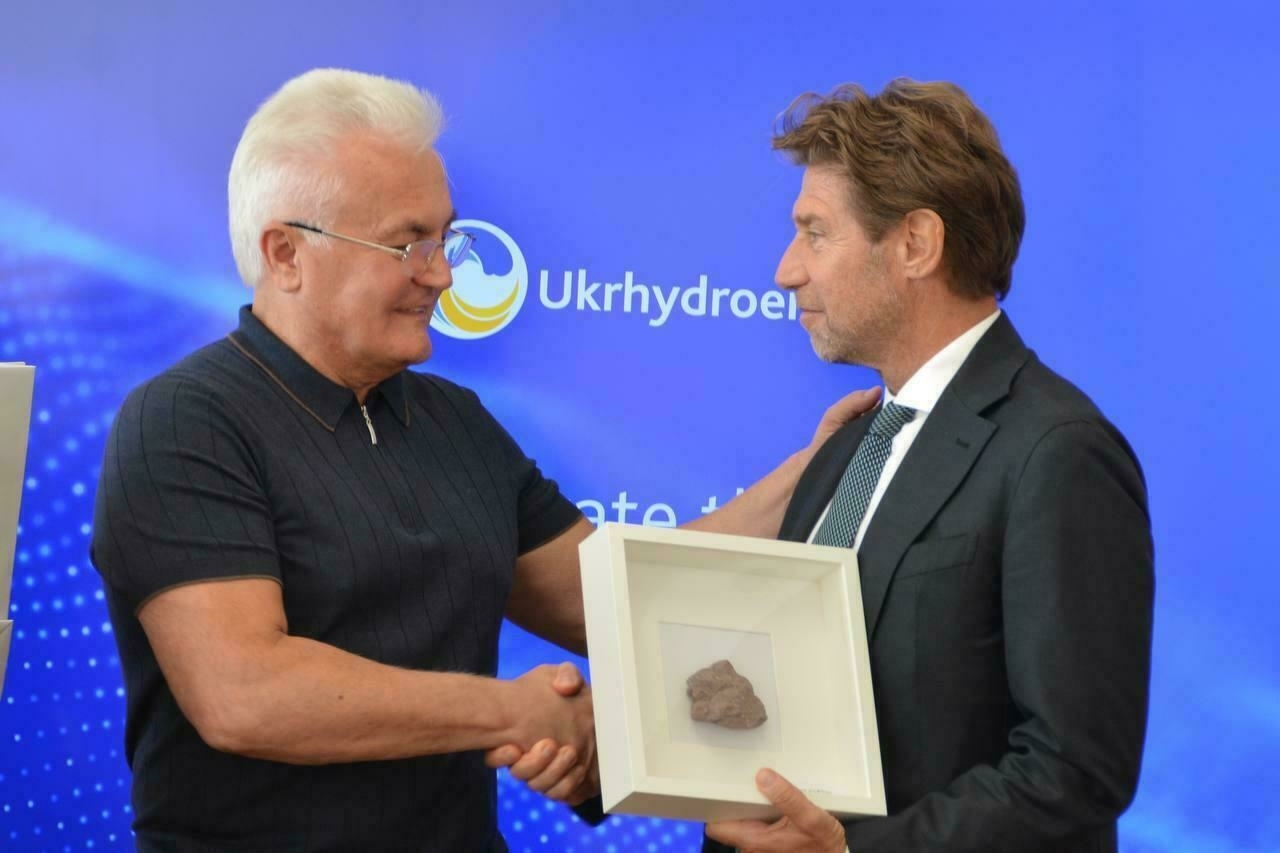
The Italian government has transferred the first 25 million euros ($28.3 million) installment to help rebuild Ukraine’s war-damaged energy infrastructure, the Italian Embassy in Ukraine told the Kyiv Independent on April 16.
The funds are part of a broader 200 million euros (around $227 million) initiative co-financed by the European Bank for Reconstruction and Development (EBRD).
The disbursed funds are directed to Ukraine’s state-owned energy company Ukrhydroenergo. The project aims to implement urgent measures to restore energy access, reinforce critical power grids, and ensure delivery of essential services in the hardest-hit regions.
“This first financing is a concrete signal of Italy’s strong support for Ukraine’s energy sector, which has been severely tested by the war,” said Italian Ambassador to Ukraine Carlo Formosa.
The initiative is also part of a 125 million euros (approximately $142 million) Italian assistance package focused on energy security and Ukraine’s reconstruction. The aid is being delivered in coordination with Ukrainian institutions and international partners.
“The country’s recovery begins with light, heat, and basic services that unite communities and make them resilient,” Formosa added.
Since the start of Russia’s full-scale invasion in 2022, Moscow has systematically targeted Ukraine’s civilian energy infrastructure.
Although Ukraine agreed to a full 30-day ceasefire in U.S.-mediated talks held in Jeddah on March 11, Russia rejected the deal unless it included limitations on Ukraine’s military and foreign aid.
A partial ceasefire, covering energy infrastructure and the Black Sea, was reached instead. Russia has since violated the terms of that limited agreement.
US softens demands on Ukraine minerals deal after Washington talks, Bloomberg reportsThe Trump administration has reportedly lowered the payback it seeks under a minerals agreement with Ukraine from $300 billion to $100 billion.The Kyiv IndependentMartin Fornusek
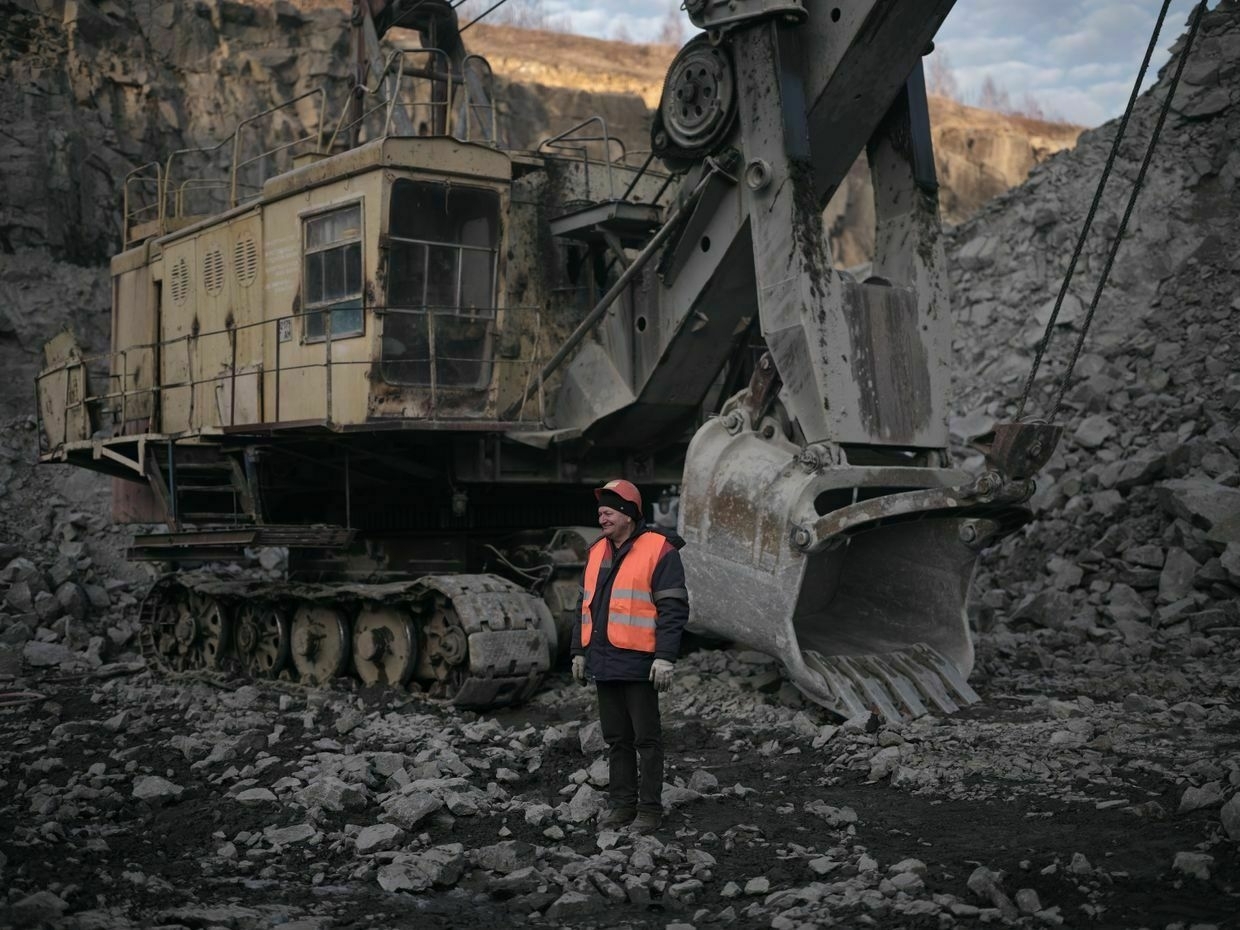
-
Trump officials 'fed up' with Europe's efforts to strengthen Ukraine, Economist reports
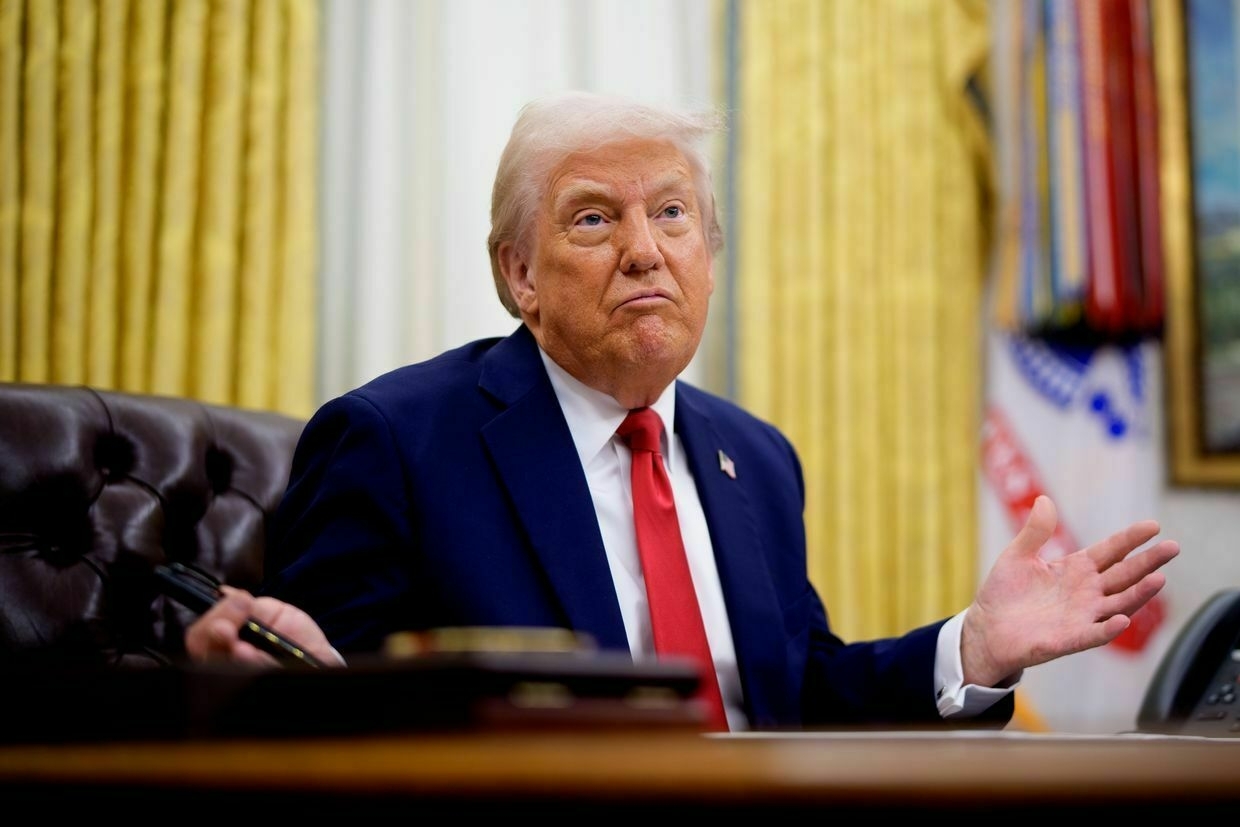
Some Trump administration officials are dissatisfied with European countries' ongoing support for Ukraine, underscoring the growing rift between Washington and Europe, the Economist reported on April 15, citing undisclosed diplomatic sources.
Kyiv’s European partners have sought to present a united front on Ukraine, pledging additional assistance and preparing a “reassurance force” of troops to monitor a potential ceasefire.
Despite efforts to keep the U.S. engaged in the process, U.S. President Donald Trump has rejected providing security guarantees to Kyiv and has not announced any new aid packages, aiming instead to broker a ceasefire with Russia.
Some Pentagon officials have even questioned an unspecified ally about why it continues sending military aid to Ukraine, a query that was ignored, the Economist reported.
The news outlet noted that the Trump administration’s “chaotic” nature makes it uncertain whether these messages have any substance or are mere “noise."
Trump has already demonstrated an unwillingness to support Ukraine militarily, even pausing all security aid in March to pressure Kyiv to the negotiating table. While the flow of these packages, approved still under the Biden administration, has resumed, they are expected to run out in the coming months.
Ceasefire efforts have nevertheless stalled as Russia continues to reject a 30-day truce supported by Washington and Kyiv and has repeatedly violated a partial ceasefire covering strikes against energy facilities.
Earlier reporting suggests that Trump’s team remains divided on how to proceed further.
While U.S. Secretary of State Marco Rubio and Special Envoy for Ukraine Keith Kellogg reportedly urged a tougher stance on Russia, Trump seems to be listening to Special Envoy Steve Witkoff, who has met Russian President Vladimir Putin three times and voiced optimism about closer engagement with Moscow.
European partners have sought to sway Trump toward providing security guarantees to Ukraine at least in some capacity, for example, by providing airpower or intelligence support for the “reassurance force.” Trump has not only offered no commitments but is also expected to reduce U.S. military presence in Europe, signaling declining interest in the continent’s security.
US softens demands on Ukraine minerals deal after Washington talks, Bloomberg reportsThe Trump administration has reportedly lowered the payback it seeks under a minerals agreement with Ukraine from $300 billion to $100 billion.The Kyiv IndependentMartin Fornusek
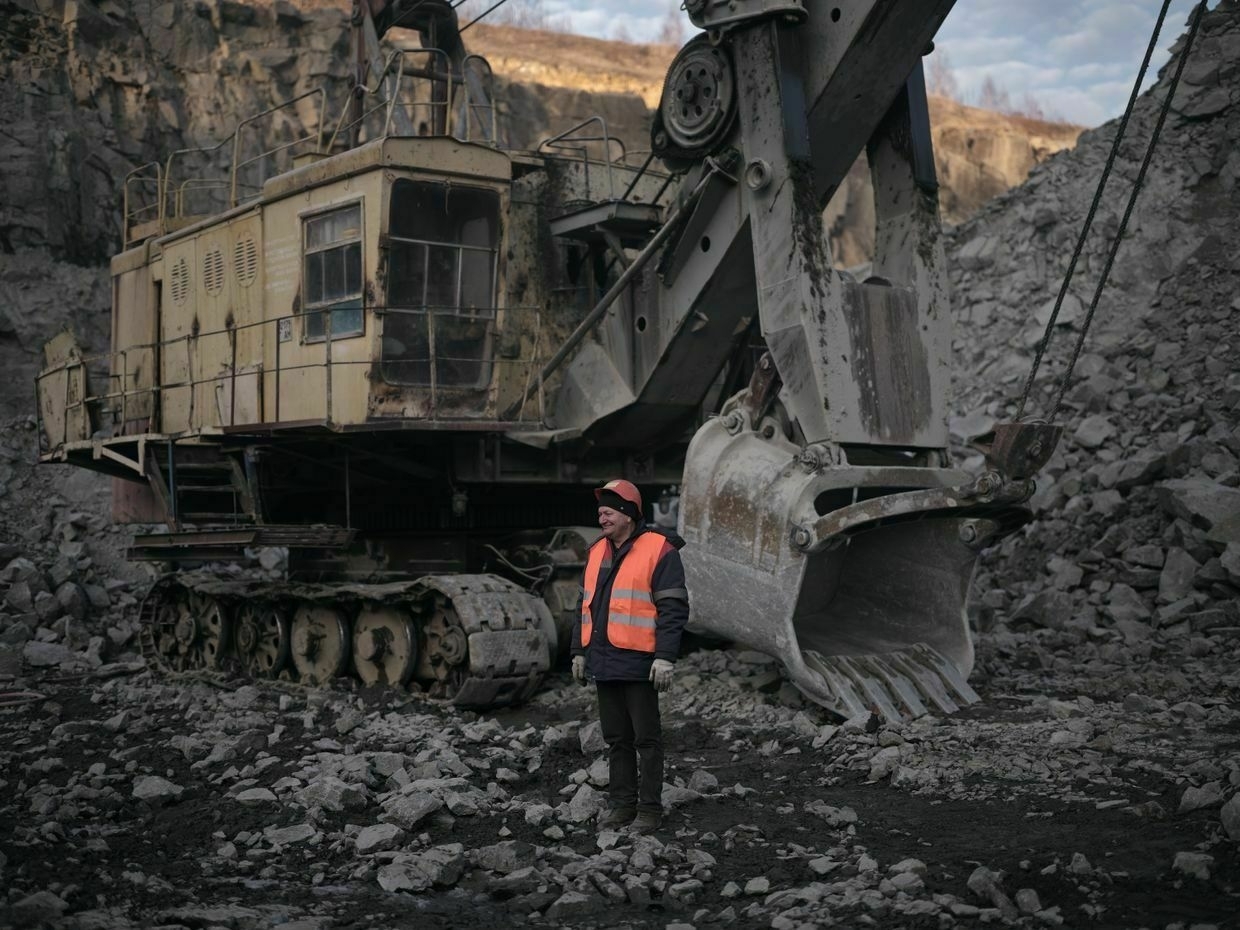
-
US softens demands on Ukraine minerals deal after Washington talks, Bloomberg reports
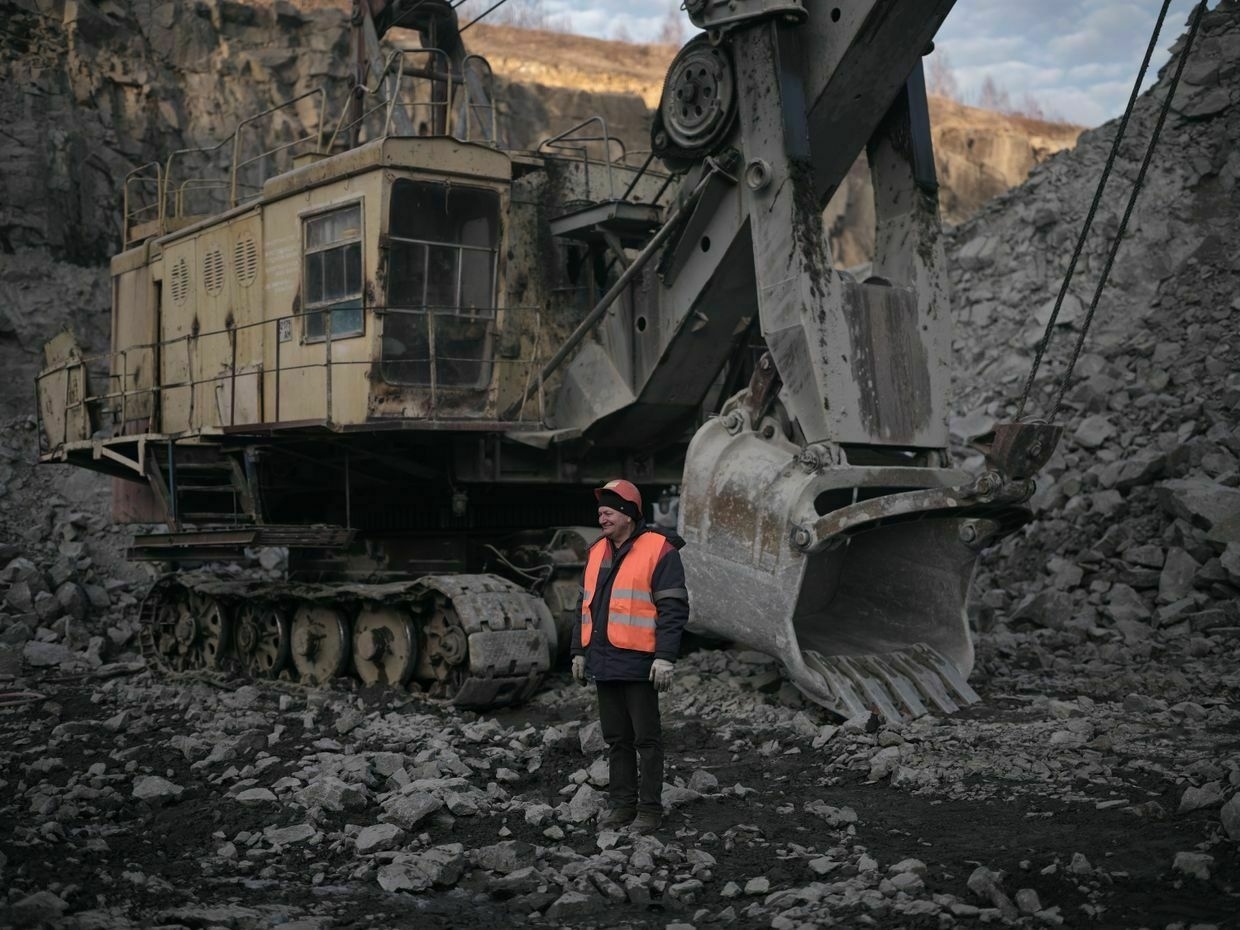
The Trump administration has lowered the payback for the provided aid it seeks under a minerals agreement with Ukraine from $300 billion to $100 billion, Bloomberg reported on April 16, citing undisclosed sources.
The news comes following technical consultations between U.S. and Ukrainian delegates in Washington on April 11 and 12, which were meant to hash out details of the long-debated deal on Ukraine’s natural wealth.
While initial reporting indicated the talks began in an “antagonistic atmosphere,” President Volodymyr Zelensky said the round of discussions concluded in a “positive mood."
Speaking to Bloomberg, U.S. Treasury Secretary Scott Bessent said that a significant progress has been made, and that the deal could be signed as early as this week.
The current U.S. proposal would grant extensive control to a joint investment fund managed by Washington. The Trump administration has framed the deal as a way to recoup the billions of dollars in military and financial aid provided to Ukraine since the start of Russia’s full-scale invasion.
While the $100 billion that Washington now reportedly seeks is closer to Ukraine’s estimates, President Volodymyr Zelensky has previously stressed that Kyiv does not see the previously provided assistance as debt.
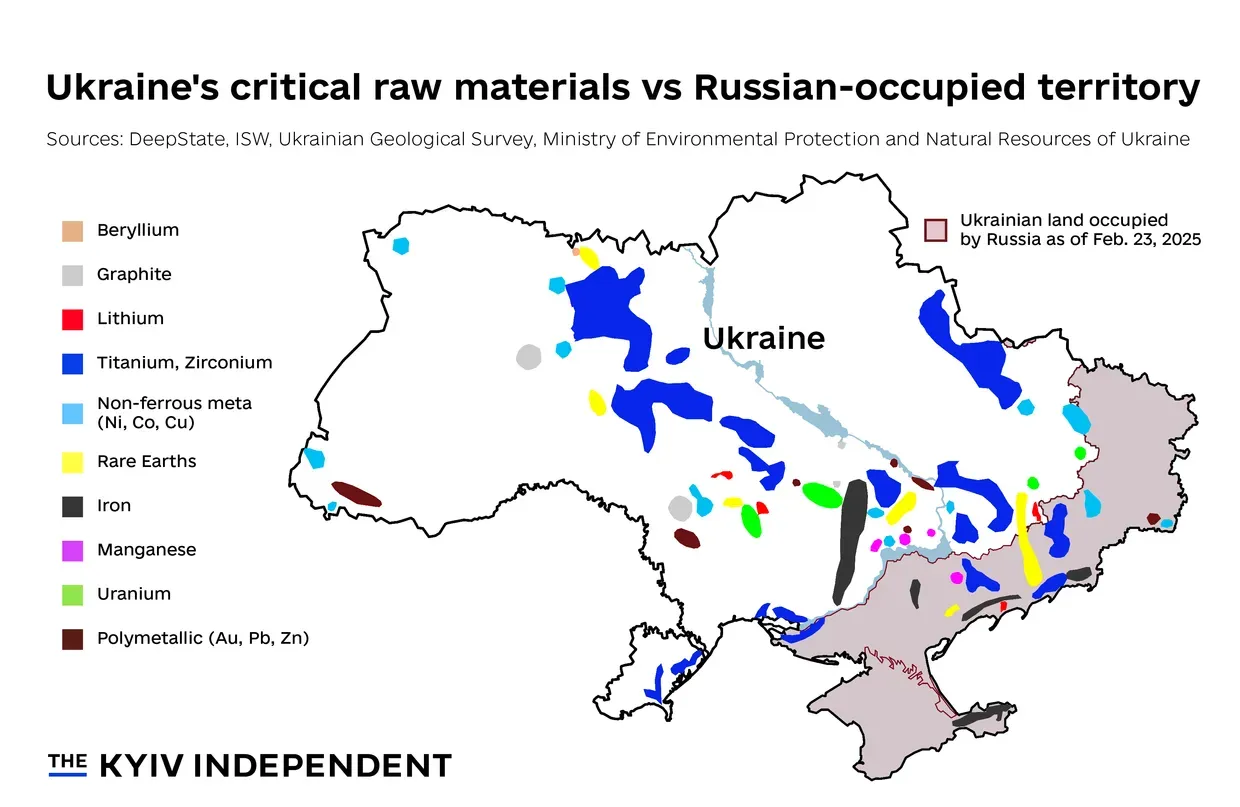
A map showing the location of critical raw materials in Ukraine. (The Kyiv Independent) Under the Biden administration, the U.S. has donated the largest volumes of arms and military equipment among Ukraine’s partners. However, President Donald Trump has yet to allocate any new packages and even briefly paused the ongoing assistance in March to pressure Kyiv into signing the minerals deal.
The original framework agreement was expected to be signed during President Volodymyr Zelensky’s visit to Washington on Feb. 28, but the plan fell apart following a heated Oval Office dispute with Trump and Vice President JD Vance. Zelensky left without finalizing the deal.
Ukraine has since hired the American-British law firm Hogan Lovells to advise on the negotiations.
Deputy Prime Minister for European and Euro-Atlantic Integration Olha Stefanishyna confirmed on April 14 that Ukraine had submitted a revised set of proposals during the latest round of talks, without commenting on the U.S.’s reaction.
Russia sees no ‘clear outlines’ yet of agreement with US on war in Ukraine, Kremlin spokesperson saysKremlin spokesperson Dmitry Peskov called the meeting between U.S. Special Envoy Steve Witkoff and Russian President Vladimir Putin in St. Petersburg on April 11 “positive and useful.”The Kyiv IndependentKateryna Hodunova
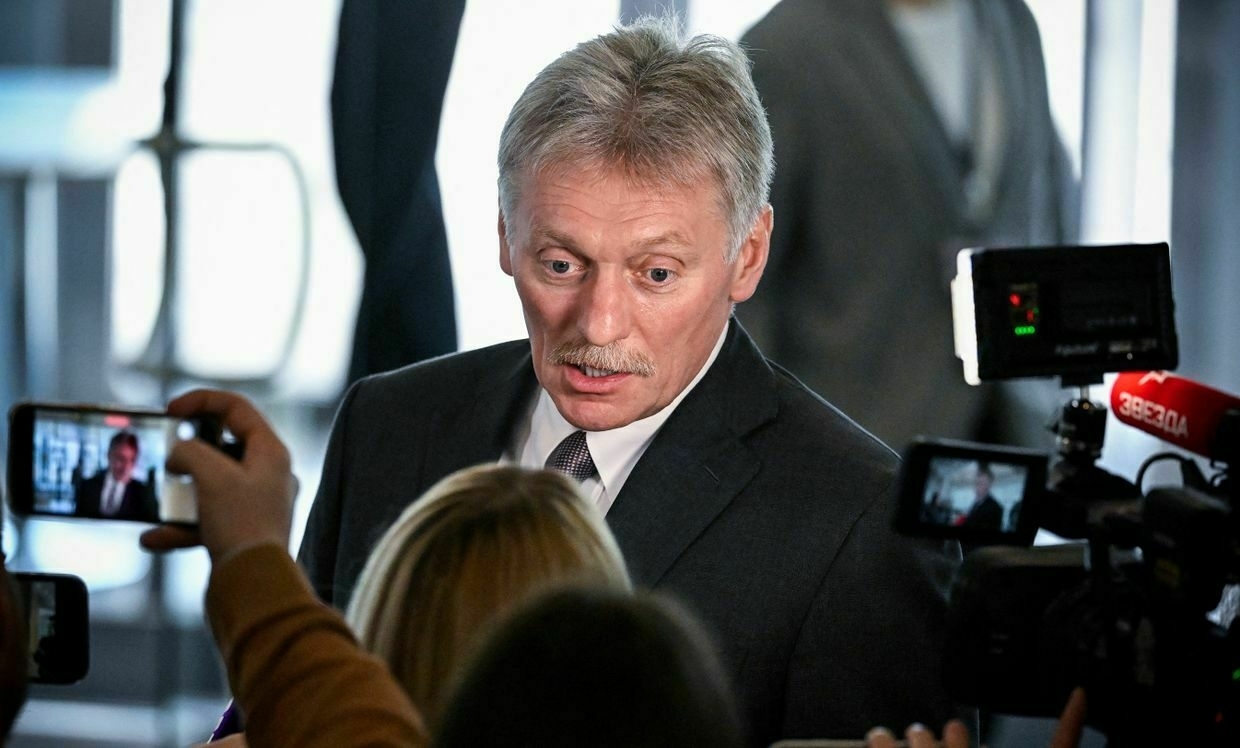
-
1 killed, 27 injured in Russian attacks across Ukraine over past day
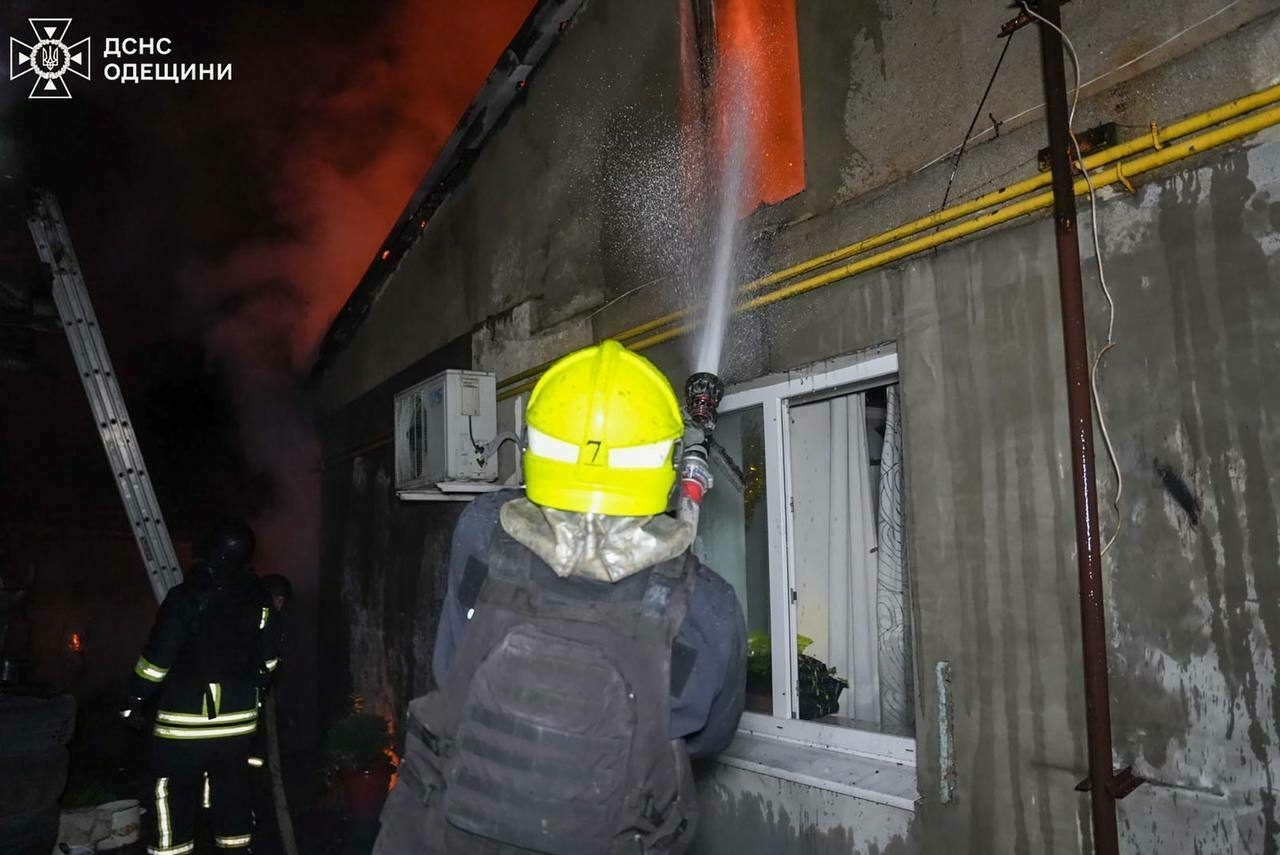
Russian attacks across Ukrainian regions killed at least one civilian and injured at least 27 over the past day, regional authorities reported on April 16.
Moscow’s forces attack Ukrainian towns and villages on a daily basis, inflicting civilian casualties and damage to infrastructure with drones, missiles, artillery, and aerial bombs.
Two men, aged 39 and 48, were injured during overnight attacks against Dnipropetrovsk Oblast, Governor Serhii Lysak reported.
In Donetsk Oblast, five people were injured in Russian attacks over the past day, namely in Sloviansk, Kostiantynivka, Lyman, Koptieve, and Berestov, said the regional governor, Vadym Filashkin.
Five people were injured in Kharkiv Oblast, including a paramedic wounded near Kupiansk when his ambulance was damaged in a Russian airstrike, Governor Oleh Syniehubov said.
In the village of Slatyne, Russian KAB bombs started a fire and damaged four two-story apartment buildings, a clinic, four garages, and five houses, according to the governor.
Russian attacks injured 11 people over the past day in Kherson Oblast, Governor Oleksandr Prokudin said. Two high-rise buildings and 11 houses were damaged.
A drone attack against the city of Odesa injured three people, damaged warehouses, and set houses on fire, the State Emergency Service reported.
In Sumy Oblast, a man was killed during a drone attack against the Velyka Pysarivka community, and another was injured in the Krasnopillia community, the regional military administration reported.
In Poltava Oblast, drone debris damaged a power line, temporarily leaving two settlements without electricity, Governor Volodymyr Kohut said. No casualties were reported.
The attacks came as Russia continues to reject a U.S.-mediated proposal for a full 30-day ceasefire. Kyiv reiterated that it would be ready to accept the truce if Moscow agreed to abide by the terms.
Trump excuses Sumy attack as ‘mistake’ — Russia’s track record says otherwiseAfter Russia launched a missile strike at the city of Sumy on Palm Sunday — killing 35 civilians, including children, and injuring over 100 others — U.S. President Donald Trump wrote off the attack as a “mistake.” “I think it was terrible, and I was told they made a mistake, butThe Kyiv IndependentNatalia Yermak
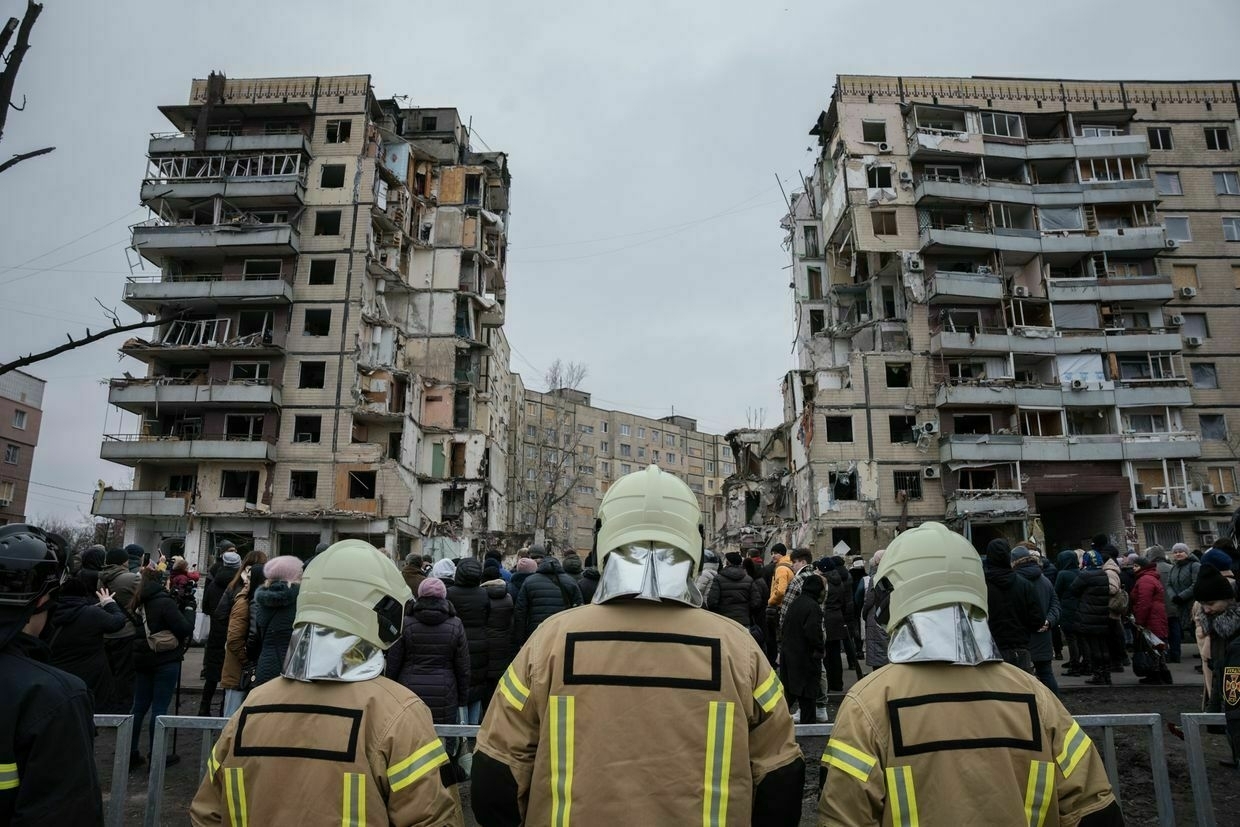
-
Ukraine-US talks on minerals deal going 'in a positive mood,' Zelensky says
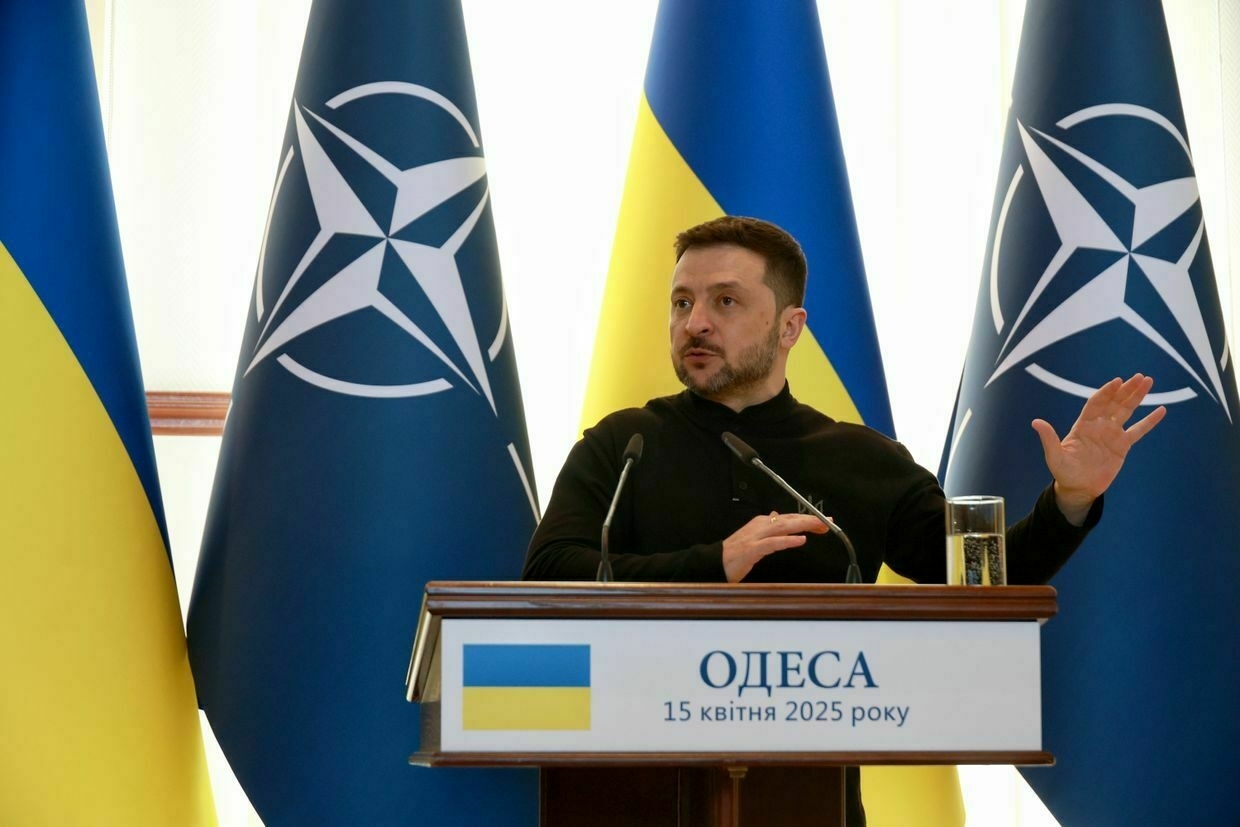
President Volodymyr Zelensky said on April 15 that negotiations on a key minerals agreement with the U.S. are progressing positively, following a round of technical consultations held in Washington on April 11.
Speaking alongside NATO Secretary General Mark Rutte in Odesa, Zelensky noted that working-level meetings would continue through the end of the week.
“When the teams are ready, they will present what they have worked out. So far, both sides have ended the meetings in a positive mood,” Zelensky said.
The talks come after months of stalled negotiations over a deal that would give the U.S. access to Ukraine’s vast reserves of critical raw materials.
According to Reuters, the April 11 discussions have been marked by high tensions, with a source familiar with the matter describing the atmosphere as “very antagonistic."
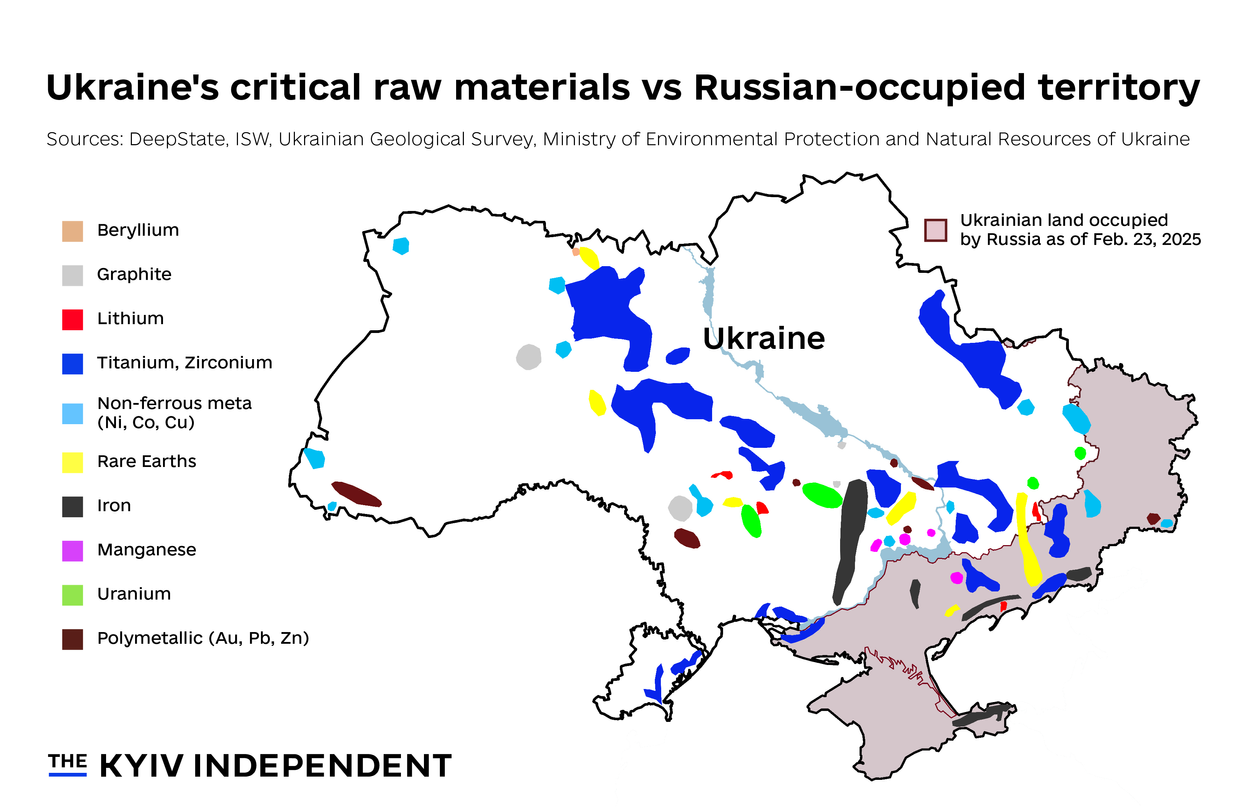
A map showing the location of critical raw materials in Ukraine. (The Kyiv Independent) The current U.S. proposal — reportedly more expansive than earlier versions — would grant extensive control to a joint investment fund managed by Washington.
Critics say the “maximalist” approach risks undermining Ukraine’s sovereignty over its mineral wealth. It could also complicate the country’s 2021 raw materials partnership with the EU, potentially threatening its EU membership path.
The original framework agreement was expected to be signed during Zelensky’s visit to Washington on Feb. 28, but the plan fell apart following a heated Oval Office dispute with U.S. President Donald Trump and Vice President JD Vance. Zelensky left without finalizing the deal.
Ukraine has since hired the American-British law firm Hogan Lovells to advise on the negotiations.
Deputy Prime Minister for European and Euro-Atlantic Integration Olha Stefanishyna confirmed on April 14 that Ukraine had submitted a revised set of proposals during the latest round of talks, without commenting on the U.S.’s reaction.
Foreign Minister Andrii Sybiha previously emphasized that any final agreement must align with Ukraine’s long-term national interests and its ambition to join the EU. Kyiv has insisted the agreement must be mutually beneficial and avoid jeopardizing future accession.
Economic partnership with US could spur Russia to end war, White House says“There is an incentive for Russia to end this war and perhaps that could be economic partnerships with the United States,” White House Press Secretary Karoline Leavitt told reporters on April 15.The Kyiv IndependentAbbey Fenbert
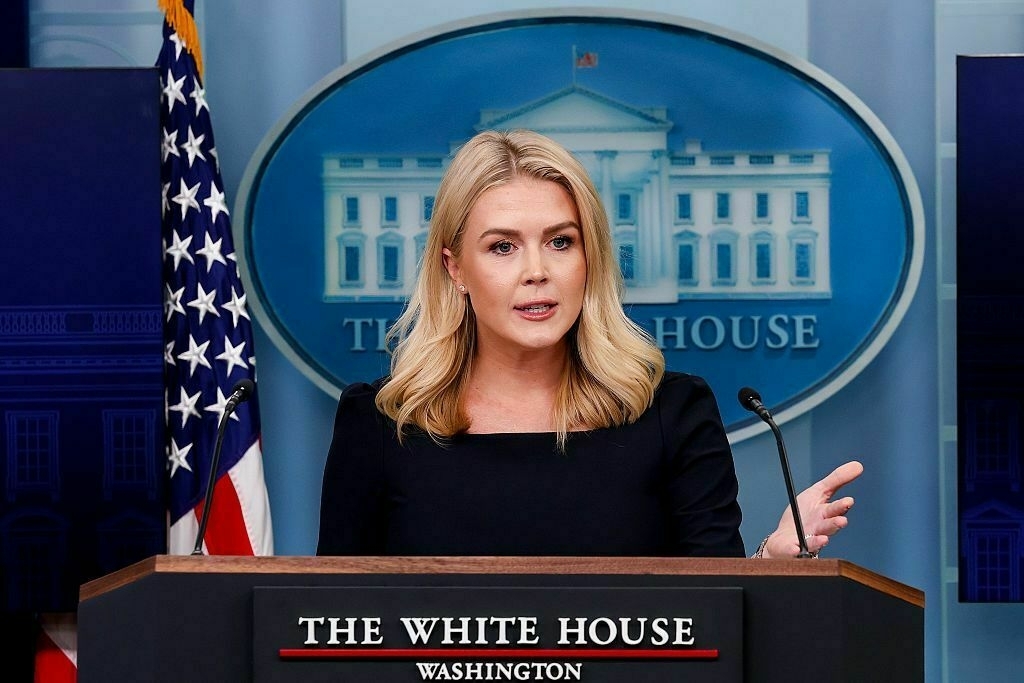
-
Economic partnership with US could spur Russia to end war, White House says
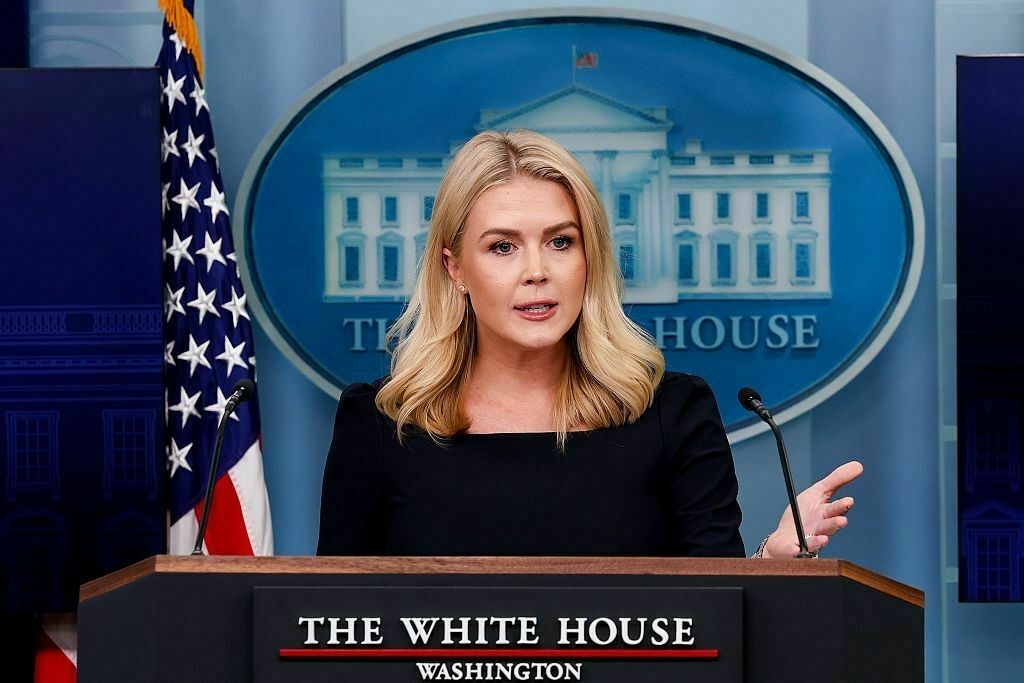
Economic partnerships with the United States could provide Russia with an incentive to end the full-scale war against Ukraine, White House Press Secretary Karoline Leavitt said at a briefing on April 15.
Leavitt’s comments come shortly after U.S. President Donald Trump’s Special Envoy, Steve Witkoff, met personally with Russian President Vladimir Putin in St. Petersburg on April 11.
The conversation with Putin was “productive,” Leavitt told reporters.
"(Witkoff) believes that Russia wants to end this war and the president believes that as well," she said.
“There is an incentive for Russia to end this war and perhaps that could be economic partnerships with the United States. But we need to see a ceasefire first and the president and the presidential envoy, Witkoff, made that very clear to the Russians."
Leavitt did not specify any current or potential economic agreements between Washington and Moscow in her comments, saying she did not want to get ahead of the official negotiations.
The previous day, Witkoff told Fox News that his talks with Putin centered around a possible peace deal based on the status of “five territories” — ostensibly Russian-occupied Crimea and the partially occupied regions of Donetsk, Luhansk, Zaporizhzhia, and Kherson. Witkoff also hinted at economic incentives for the U.S. and Russia.
“I see a possibility of reshaping the Russian-United States relationship through some very compelling commercial opportunities,” he said. “That gives real stability to the region too."
Since Trump took office in January, Washington has taken steps to normalize relations with Moscow, with an emphasis on economic ties. Following a phone call between Trump and Putin on March 18, the Kremlin said the leaders were interested in developing “mutually beneficial cooperation” in a number of sectors. The White House later touted the potential for “enormous economic deals” between the two countries.
The Trump administration is also pursuing a minerals deal with Kyiv that would give the U.S. broad control over revenues from Ukraine’s natural resources. The U.S. claims the agreement would help protect Ukraine against Russian aggression, though it includes no security guarantees.
While the Trump administration insists the Kremlin is ready to make peace, Russia continues to launch deadly attacks on Ukraine’s civilian centers. Russia targeted the northeastern city of Sumy with ballistic missiles the morning of Palm Sunday, killing 35 people and injuring 117.
Russia also refuses to accept Washington’s call for a full 30-day ceasefire — a proposal Kyiv has already backed. A partial truce covering energy infrastructure has repeatedly been violated by Russian forces.
Ukraine war latest: Ukrainian forces target Russian missile brigade behind deadly Sumy attack; Witkoff unveils ‘5 territories’ deal for RussiaKey developments on April 15: * Ukrainian forces target Russian missile brigade behind deadly Sumy attack * Witkoff says ‘5 territories’ key to proposed Russia-Ukraine deal after meeting Putin * North Korean artillery now dominates Russia’s ammunition supply in war against Ukraine, investigation…The Kyiv IndependentThe Kyiv Independent news desk
